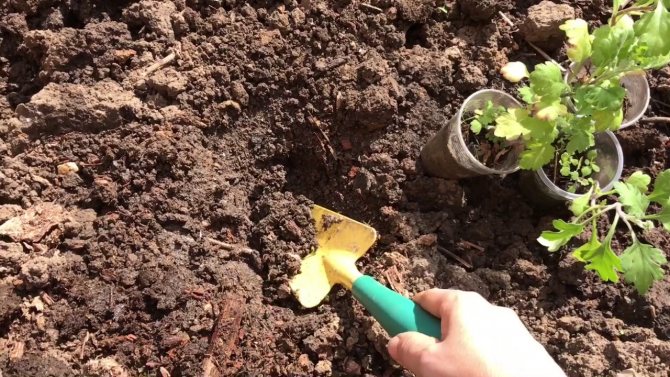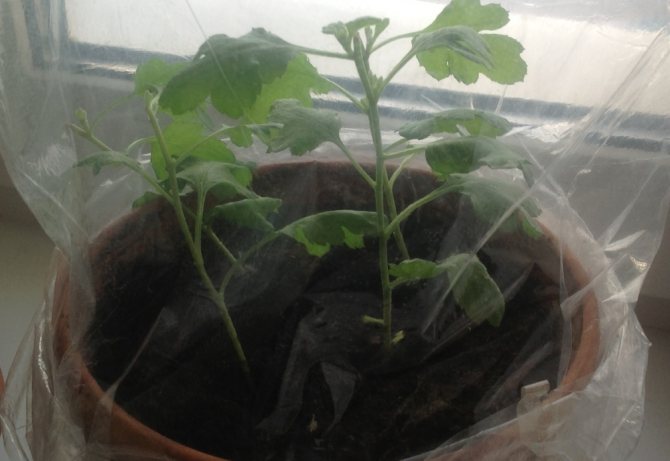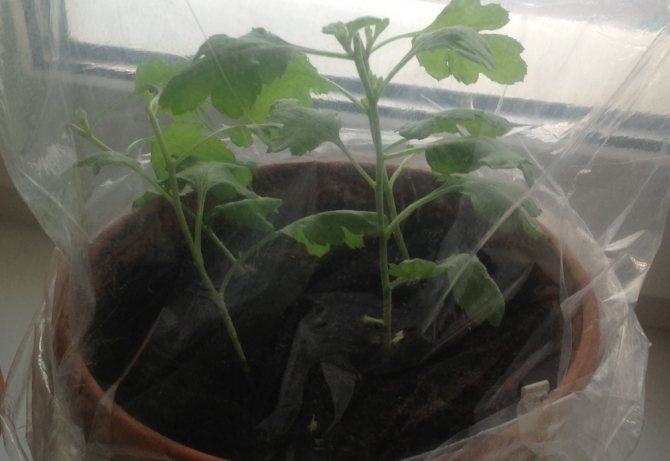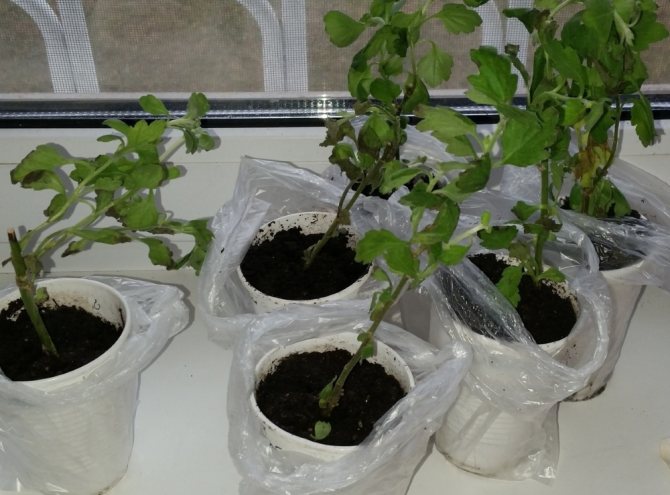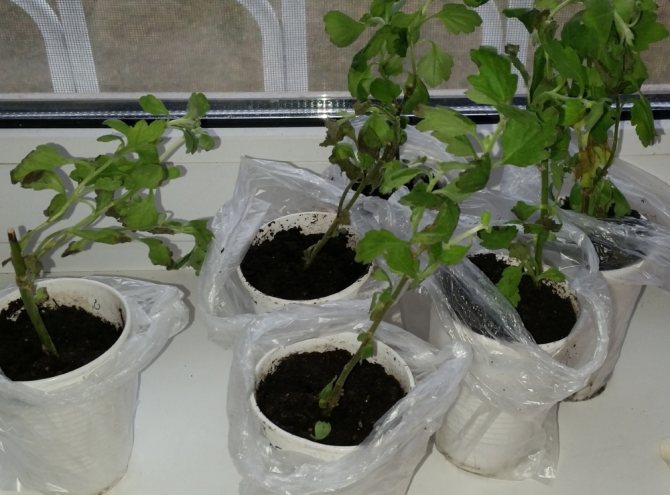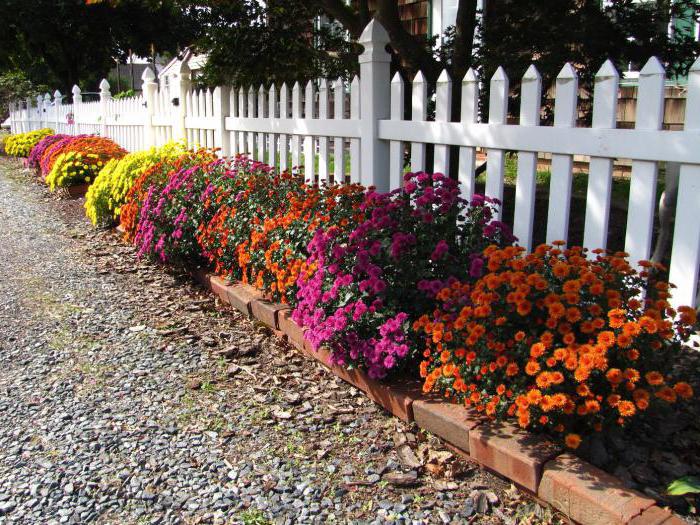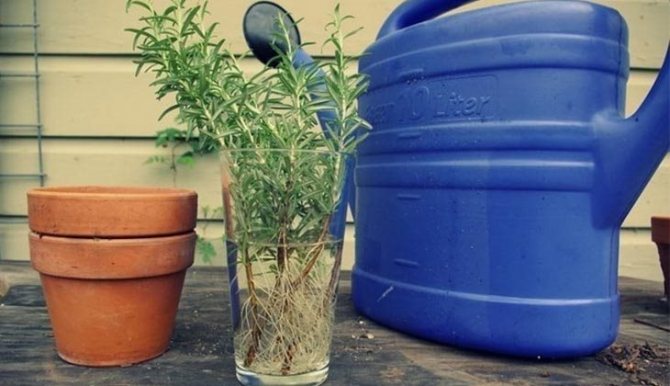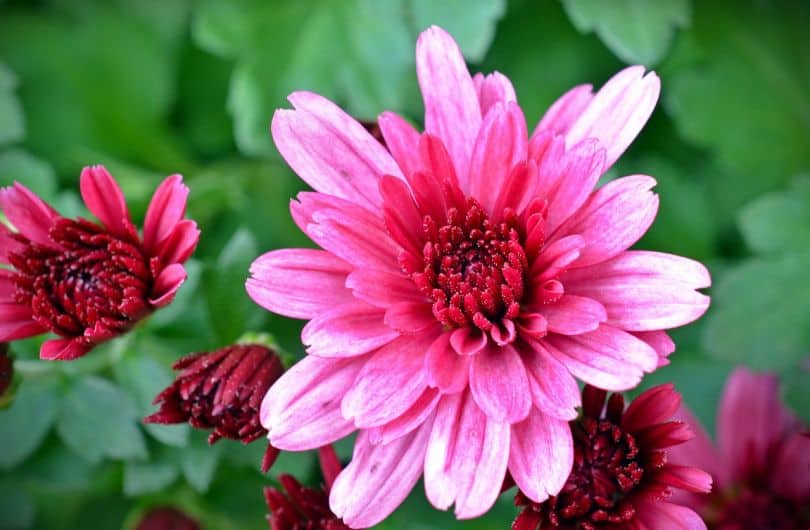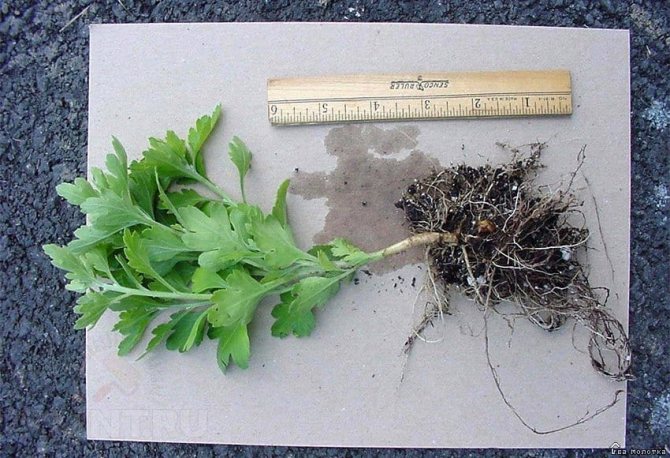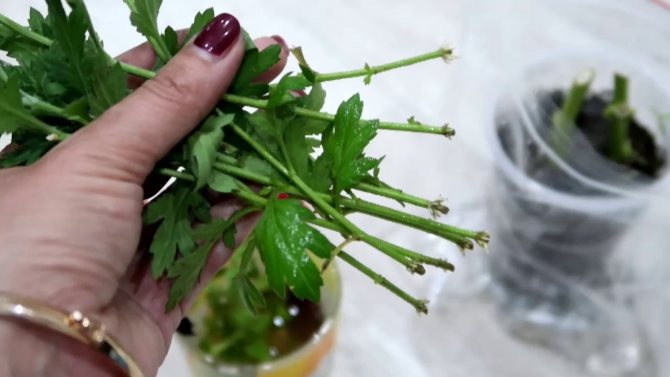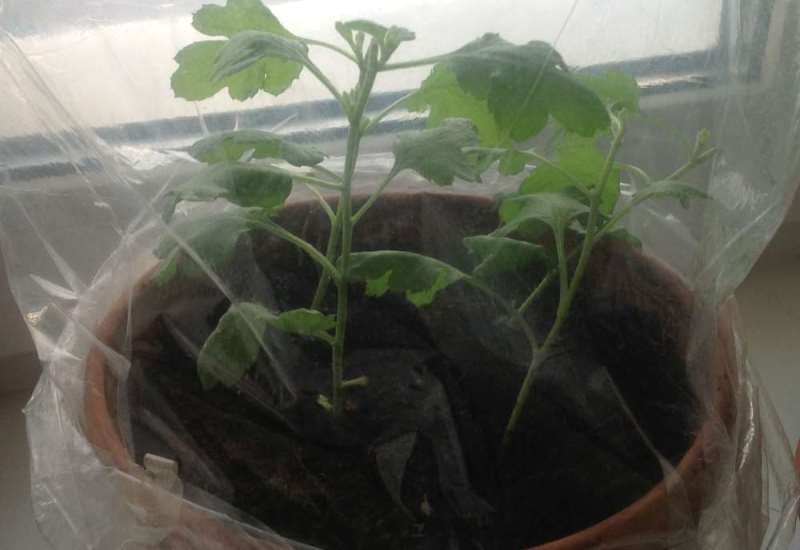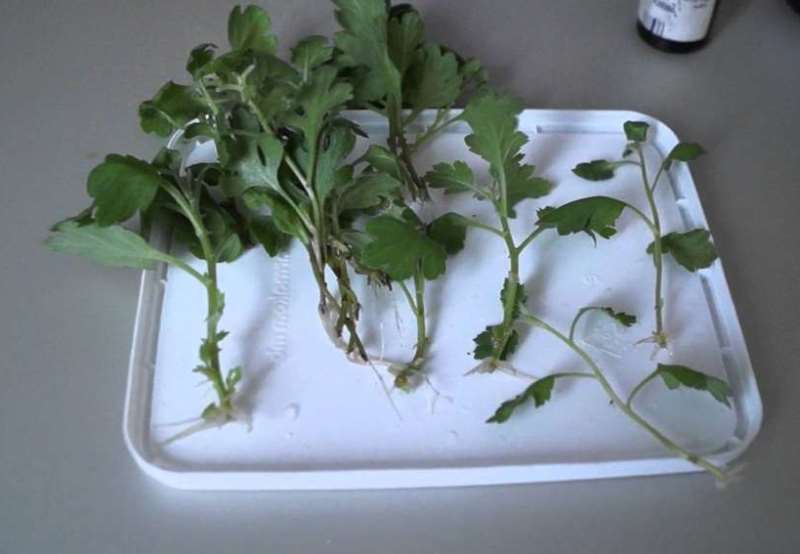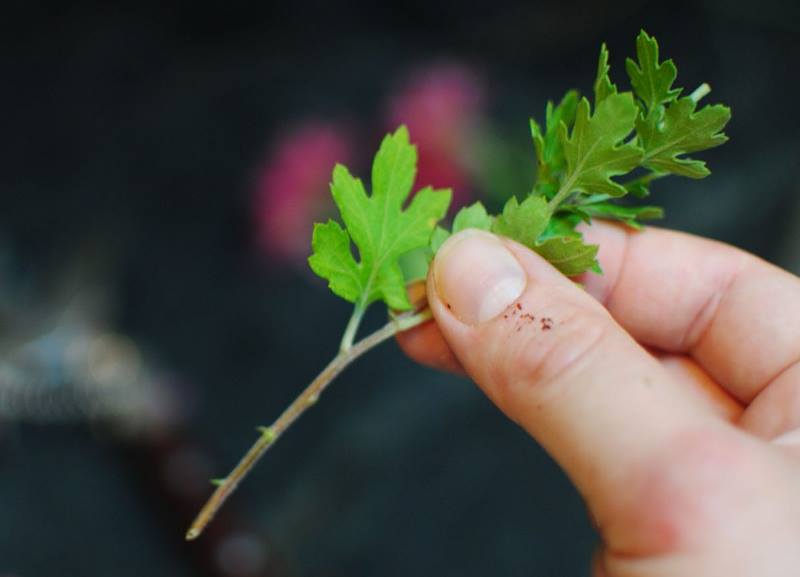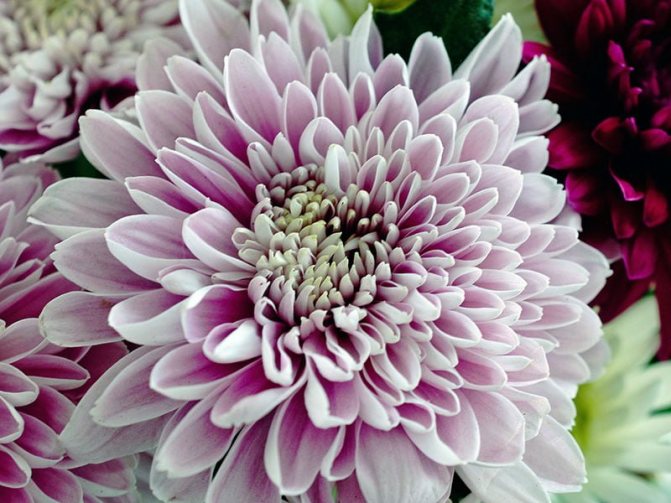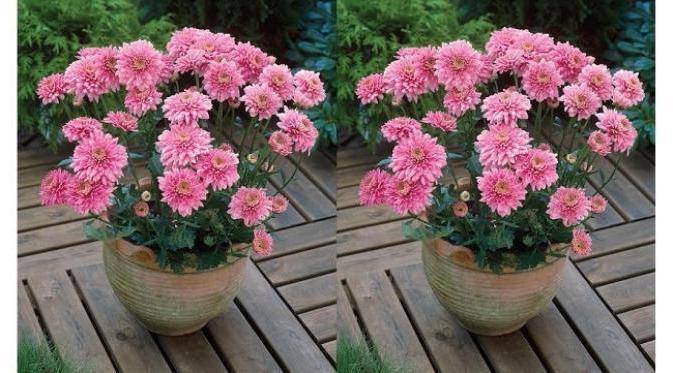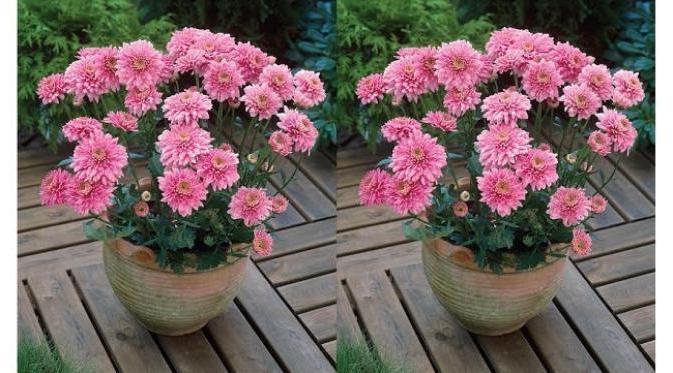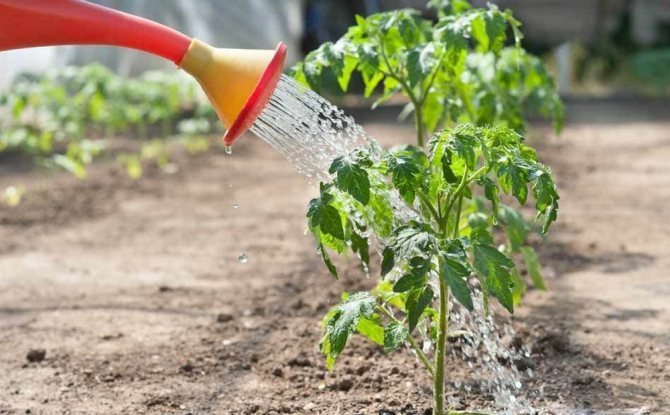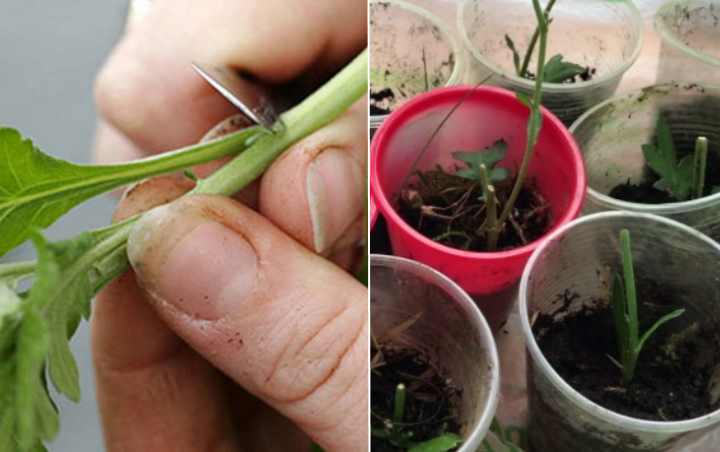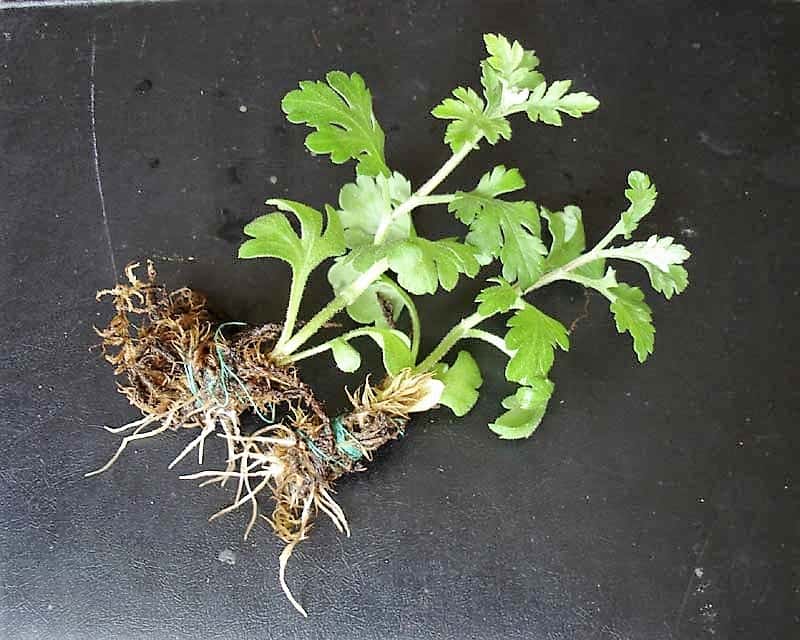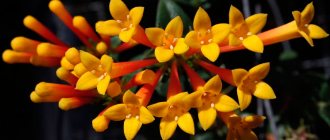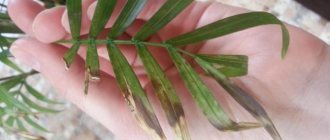Many people are familiar with the situation when they presented a bouquet of chrysanthemums, and it stands for weeks in a vase, still fresh and beautiful. Involuntarily, the thought creeps in about whether it is possible to plant these bushes in your garden. It turns out yes: chrysanthemum stalks take root very easily. Let's find out what needs to be done to root cuttings from a bouquet and grow beautiful flowers from them in the open field or in a flowerpot.
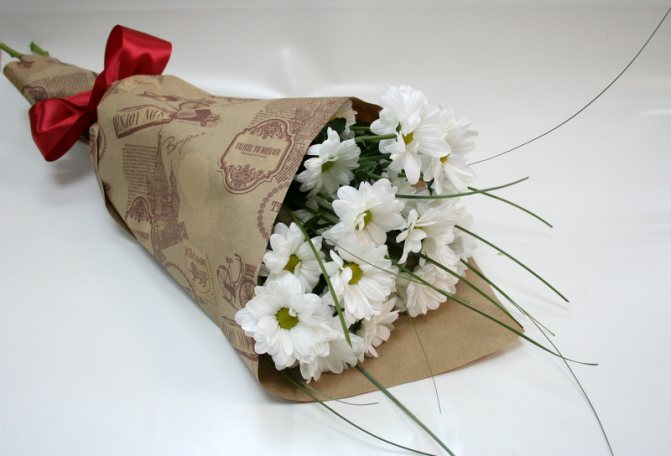
Features and varieties
The spherical chrysanthemum can be successfully grown outdoors, in greenhouses, as well as in a pot culture.
The most important feature of the multiflora chrysanthemum: the genetic ability to form a spherical crown. A stalk, planted in the ground in spring, immediately begins to branch abundantly. Without pinching and pinching! Therefore, it is not necessary to specially form a chrysanthemum from the multiflora group, it will do it on its own.


Ball-shaped crown - natural for chrysanthemum multiflora
An adult bush reaches a height of 20-80 cm, the diameter is the same. In autumn, it is covered with many small flowers with a diameter of 2-6 cm. The flowering of some varieties is so abundant that the foliage ceases to be visible at all. That leaves a solid flower ball! At the same time, the color of the inflorescences can be very diverse: any shades of red, pink, yellow, beige, white, bronze. There are spherical chrysanthemums with greenish flowers, in the photo below is the Primo Pistache multiflora variety.
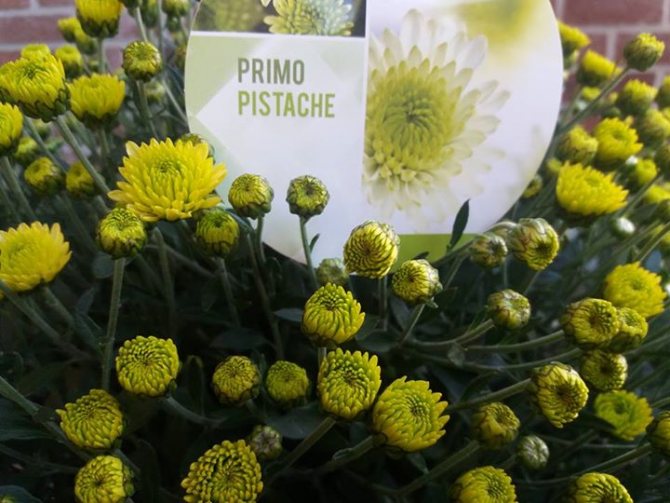

Chrysanthemum multiflora Primo Pistache
By the time of flowering, chrysanthemums are divided into:
- early - the beginning of flowering in August;
- medium - the beginning of flowering in September;
- late - beginning of flowering in October.
Residents of the northern regions (in Siberia, in the Urals) should choose early flowering spherical chrysanthemums. This will make it possible to admire their beauty even in a harsh climate for about 2 months. Late flowering varieties in the north may simply not have time to bloom before the arrival of frost.
In warmer regions, the choice of a variety for flowering time is not so acute. Southerners can easily afford to grow multiflora chrysanthemums of any flowering period. Even late-flowering varieties will have time to bloom here and will delight their owners until mid / late November.
To find out the flowering period of a particular variety, you can refer to foreign catalogs. They often indicate the number of the week from which flowering begins. For example, in the GEDIFLORA catalog (Belgium) it is indicated that the Fonti variety series begins to bloom at the 32nd week (counting from the beginning of the year), which corresponds to the beginning of September. On the 34th week (mid-September), the Pobo, Axima variety series show themselves in all their glory. These are all early varieties of multiflora. But the variety series Mefisto - blooms at 42 weeks (mid-October) and paints an almost empty garden with its colors.
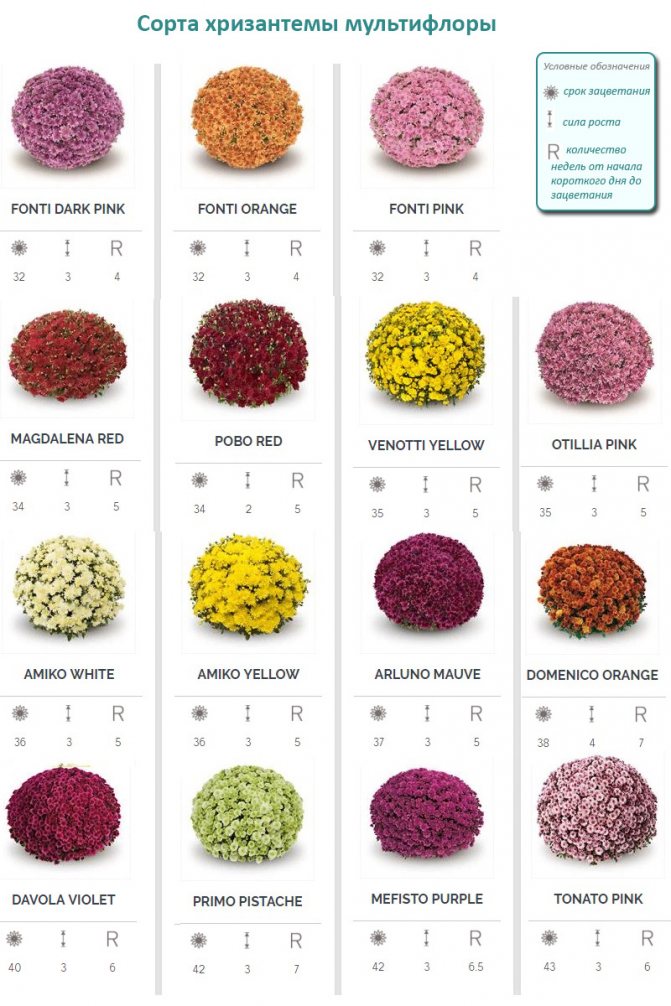

These terms can only be guided by, without complete binding. Depending on the climate of your region, weather conditions of a particular year, the flowering time of spherical chrysanthemums can vary significantly in one direction or another (on average, by 10-20 days).
By dividing the bush
Dividing a bush is a simple method in the reproduction of perennial chrysanthemums. Such a breeding process is carried out in the first half of June or at the end of August until the beginning of autumn (throughout September).For dividing the bush, the strongest, healthy and beautiful flowers with well-developed inflorescences are selected. Preference should be given to bushes that have not been reached by pests.
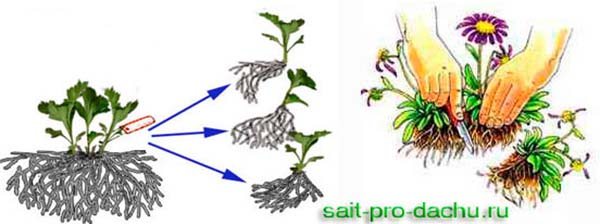

Reproduction of chrysanthemums by dividing the bush
The number of parts into which the bush is divided is determined by the characteristics of the variety, as well as the number of years of mother plants. A three-year-old bush is capable of producing 5 - 6 cuttings. To get "delenki", uterine bushes are dug up and divided into parts that have a root system with shoots. They are planted in open ground, placed in fertilized holes, and are well watered.
If reproduction takes place in the autumn, then young bushes will need to be covered for wintering with oak branches, needles or branches of thorny bushes without foliage.
Chrysanthemums garden perennial varieties
Ball-shaped chrysanthemum: planting and care
The bulk sale of multiflor begins in September. They are usually sold in pots as gift plants. And many buy them, hoping to grow them in the future at home, on the windowsill. However, this is not a house plant, in the conditions of an apartment it will not show itself in all its glory. But on the balcony - please. Chrysanthemum multiflora is a wonderful, not capricious plant for balconies, verandas and terraces. And of course, it can be grown outdoors.
Disembarkation
A spherical chrysanthemum is planted in open ground in the spring - usually in the form of rooted cuttings or root growth. In Ukraine and in the southern regions of Russia, you can time the landing by April, in the middle lane - by May, and in the northern regions - by the first days of June. Focus on your climatic zone and the possible risks of return frost.
When planting, a minimum of 40-50 cm is left between the plants. Even between small cuttings! Do not look at their small size, by July-August they will become wide fluffy balls.
Sometimes multiflora is planted as adults, flowering - immediately after purchase. In warm regions, this method is fully justified. At the end of summer or even in warm September, if the frost is not yet soon, the spherical chrysanthemum will have time to take root in the ground and survive the winter (the photo below shows just such a planting of an adult flowering bush). In the middle lane, multiflora planted even at the beginning of autumn will most likely die from winter frosts.


Summer planting of chrysanthemum multiflora in the ground
The landing site is sunny, open. In the shade, the spherical chrysanthemum will stretch out or grow lopsided. On the balcony, to solve this problem, you will have to periodically turn the pot with the plant so that all its sides get an equal share of the required suites.
When growing in a pot, 1-3 liters of soil should be allocated for each plant. Naturally, in a liter pot, the ball will be small and compact. In a 3-liter, it is more significant. Everyone has their own idea of beauty, choose what you like best!
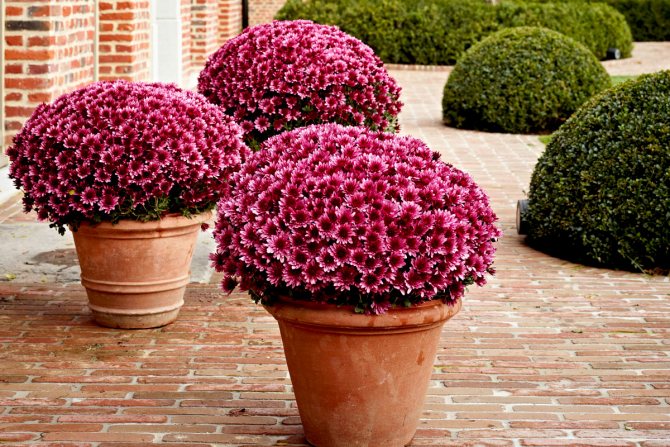

Chrysanthemum multiflora in pots
Watering
On hot days, multiflora can suffer greatly from lack of moisture. Then their leaves will turn yellow, and the branches will become lignified ahead of time, the budding process will almost certainly slow down. Therefore, in the summer, it will be necessary to water spherical chrysanthemums every day, especially for container plants.
Top dressing
In the vegetative phase of growth (during a set of green mass), fertilizing with a predominance of nitrogen (N) is used. For the formation of the root system, cell walls, as well as for better absorption of nitrogen, it is recommended to add calcium (Ca) to the nutritional diet. For example, in the form of calcium nitrate, which contains both calcium and the necessary nitrogen.
In the reproductive phase (when the budding process is in progress), the composition of fertilizers is changed to phosphorus-potassium fertilizers.
The interval between dressings is 7-10 days.
Breeding methods
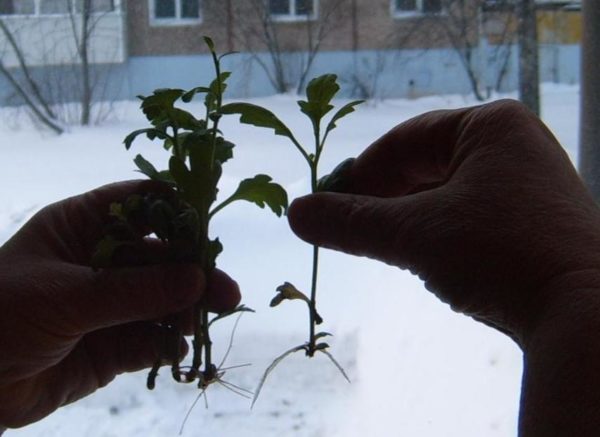

All varieties of a flower are propagated in several ways: by seeds, dividing the bush, layering and cuttings. All options are quite simple, knowing a few nuances, even those who have never encountered the cultivation of this flower can cope with them. Amateur gardeners, for some reason, prefer vegetative propagation of chrysanthemums, in order to understand why, we will analyze each method.
Seed propagation
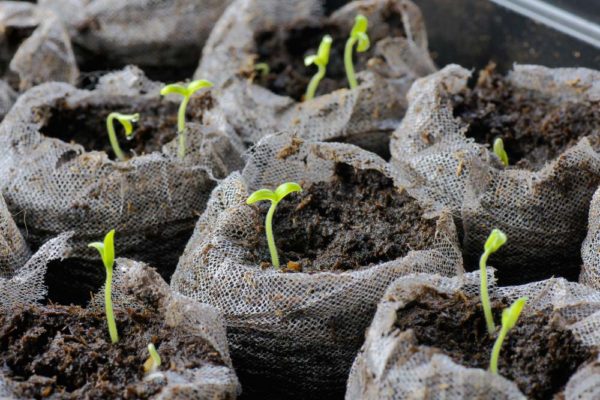

If you want to grow chrysanthemums from self-collected seeds, be prepared for the fact that the plant will most likely not show the varietal characteristics of the parent plant. Sowing material purchased from a trusted company will give varietal offspring, but some of the seeds may not hatch. You should not buy seeds from open containers in spontaneous markets. How to sow seeds outdoors:
- do a shallow digging of the area allocated for chrysanthemums;
- dig small holes (up to 5 cm deep) at a distance of 30 cm from each other;
- Pour each hole with warm water and put 3-5 grains in it;
- sprinkle the seeds with earth and make a small greenhouse over the crops. You can insert several pegs around the perimeter and stretch transparent polyethylene;
- as soon as the first shoots appear, remove the shelter;
- periodically loosen the soil and remove weeds;
- 10 days after pecking the seeds, carry out the first top dressing, flower growers use universal fertilizers such as Rainbow;
- when the seedlings grow to 8-9 cm in each hole, leave 1 or 2 of the strongest shoots, transplant the rest to another place or share the planting material with your neighbors.
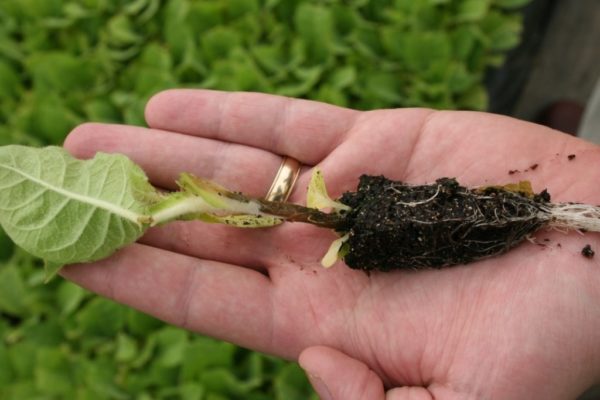

It is advisable to propagate by seeds only small-flowered and annual varieties of chrysanthemums. With early spring sowing in open ground, the bushes will bloom not earlier than mid-autumn, so that the buds open in the summer, planting through seedlings should be carried out. The procedure is carried out from mid-February to early March. How to germinate chrysanthemum seeds at home:
- lay a drainage layer on the bottom of a wide, shallow container, pour a special soil mixture for chrysanthemums into the container;
- Spread the seeds on the surface of the soil in any order, but do not overdo it with the number of grains. If the varieties are annual, sprinkle them with earth a little, and if they are perennial, lightly press them into the soil;
- spray crops with warm water from a spray bottle, cover the container with plastic or glass. Remove the cover from time to time for ventilation;
- the first shoots will appear in about 10 days, transfer the containers to the lightest windowsill and gradually begin to harden the seedlings. First open the window for an hour, gradually increase the time;
- thin out the shoots at the stage of formation of 3 or 4 leaves. Before planting in open ground, water the seedlings abundantly with water.
Watering at all stages of seedling development should be carried out regularly, but in moderation. Avoid waterlogging and drying out of the soil, use only warm, settled water. The temperature in the room with seedlings before hardening should be about + 22-26 degrees. Feeding with Zircon will help speed up the rooting process of chrysanthemums after a pick. When using fertilizer, the temperature in the room is lowered to + 15-19 degrees. Transplanting flower seedlings to a permanent place is carried out after the last spring frosts.
Reproduction by dividing the bush
It is recommended to plant a chrysanthemum growing in one place for more than 3 years. Dig up the entire bush carefully, it is important not to damage the root. Cut off old lignified shoots with a sharp garden knife or pruning shears, separate the young branches from the mother bush along with the roots. If the stems have long branches, it is best to carefully cut them off. Plant each plot at a distance of 30–35 cm from each other. The procedure is carried out in late spring or in the second half of August.
Reproduction by layering
The method is suitable for indoor, as well as for garden winter-hardy varieties of chrysanthemum. Dig a small, oblong hole near the mother plant, the width and depth of the hole should correspond to the size of the bush. Gently bend the flower stems and fix with pegs or staples at the bottom of the prepared hole, cover with a layer (about 25 cm) of earth, leave the bush in this form for the winter.
In the spring, after the plant wakes up, new, already rooted shoots will hatch from the buds. When the return frosts have passed, dig up the mother bush and separate each stalk together with the root, transplant to a new place. Do not throw out layers with a poorly developed root system, transplant them, like the rest, with proper care, they will quickly catch up with stronger shoots in growth.
Propagation by cuttings
The rarest and most valuable varieties are best propagated by cuttings. The Korean variety of a flower, when breeding by division, may not take root well in a new place. Cuttings of this variety root perfectly, retain their specific features, and quickly adapt after planting. Flowers grown from green, not lignified cuttings are resistant to low temperatures and diseases, are distinguished by a lush crown and rich flowering.
Gardeners divide seasonal cuttings into 2 types: early and late. The first ones are prepared in the fall, germination is carried out in the winter (from January to the end of February). These cuttings take root within 30 days. The latter are cut in April or May and take root in 7 or 14 days. Experts advise to start harvesting cuttings in late autumn, or at the beginning of winter (in warm regions) when the first frosts catch the soil. Features of autumn cuttings of chrysanthemums:
- small-flowered varieties take root earlier than large-flowered varieties;
- thick, fleshy shoots do not take root well;
- flowers of the same variety, when rooting early and late cuttings, will bloom at the same time;
- the period of cuttings has a strong effect only on the habit of the bush; taller shoots grow from early cuttings.
Some gardeners cut flower cuttings in the first half of autumn, when the bushes are just beginning to bloom. This method can be recommended exclusively as an experiment, because not all varieties and hybrids of a flower are ready for reproduction by this time. Bushes grown from cuttings can bloom in spring or autumn, in rare cases the next year after planting in open ground, much depends on the variety and germination conditions.
Blooming spherical chrysanthemums
Chrysanthemums need short daylight hours to set buds - on average, less than 14-12 hours.
To initiate flowering ahead of schedule or generally all year round, greenhouse farms use controlled crop technology. This is a complex process associated with the artificial creation of an "autumn" climate. In this case, the main event is shading chrysanthemums with a black film and reducing daylight hours to 9-10 hours. After 3-4 weeks, a bud is formed. After another 4 weeks, full flowering begins. Therefore, foil cover starts 8 weeks before the required flowering date. Shading can be stopped after the buds are colored.
A similar programming of flowering dates can be applied at home, when growing chrysanthemum multiflora in pots on the balcony.
In addition to the short daylight hours, the temperature regime is important for the flowering of chrysanthemums. Ideal temperatures are 15-20 ° C for setting buds, and around 10 ° C for flowering.
Read also Materials for stone processing
To speed up the flowering of multiflora, you can apply:
- fertilizer with a high content of phosphorus and potassium. For example, potassium monophosphate or Plantafol with the formula NPK 5-15-45;
- spraying with Epin - 3 times, interval 10 days;
- spraying with stimulant bud.
Cutting chrysanthemums is the best way to reproduce
When growing chrysanthemums from seeds, the loss of their varietal characteristics is often noted. The most reliable way to reproduce valuable varieties in large quantities is considered to be cuttings. This method is a type of vegetative propagation. The Korean chrysanthemum, popular in recent years, is sometimes propagated by dividing the bush. Moreover, the percentage of its reproduction is quite low. Chrysanthemum cuttings of this species root easily and retain all the specific features of the original plant. Thanks to this method, any interesting variety can be quickly propagated.
"Early" cuttings are those grown in winter (January-February) with short daylight hours. They take root within 1 month. "Late" cuttings, obtained in April-May, develop roots in 1-2 weeks.
Chrysanthemum multiflora wintering
You can save chrysanthemum multiflora in winter:
- in the open field;
- in a basement (dark, cold place);
- on the balcony (bright, cool place).
Outdoor wintering
A distinctive feature of multiflora chrysanthemum is winter hardiness. Many varieties (not all, it is necessary to check!) Hibernate in open ground with shelter, even in the middle lane. This method is not suitable for northern regions.
Wintering in the ground has some nuances. When the spherical chrysanthemum flourishes, its branches are cut to a height of 5-10 cm. Then they are spud with peat, dry leaves, straw, the same cut branches, spruce branches. For more protection from above, you can cover this structure with agrofibre.
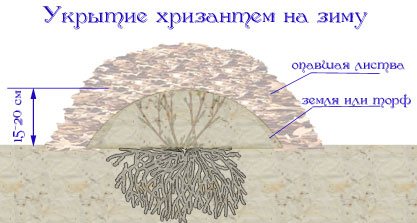

Chrysanthemum wintering in the open field
If you decide to keep multiflora in the ground, initially plant them in a place where water does not stagnate during winter thaws and early spring. Chrysanthemums are much more afraid of getting wet and damping than frost. For the same reason, in the spring, it is necessary to remove the shelter in time, otherwise the plants will rot.
In the basement
In regions with harsh winters, the globular multiflora can be dug up and stored in a basement or cellar. The same method should be preferred when "getting acquainted" with a new variety, if there is no confidence in its winter hardiness.
Preparation for winter is performed as follows. Before the onset of frost, chrysanthemums are dug up, cut to 5-10 cm and, together with a lump of earth, are transplanted into a pot or box. If the plant is already growing in a pot, simply prune it. Plants are lowered into the basement with low positive temperatures (2-4 ° C). The soil on the roots should be moist, but not wet. In winter, you should periodically check the condition of the mother liquors and spray the soil when it is dry.
Closer to February or early March, the chrysanthemum will begin to come to life, shoots will appear. Then it is taken out to a warmer and brighter room, and after the branches have grown, they are cut or divided. Each stalk (or cut), subsequently planted in the ground, will give life to a new blooming ball.
On the balcony
A great method for city dwellers who bought potted chrysanthemum multiflora. It is good because you can see wintering plants every day and monitor their condition.
Any glazed balcony or loggia, veranda is suitable for wintering. That is, any bright and cool place in which the temperature remains in winter is 3-10 ° C. Moreover, quite wide variations of this range are allowed, nothing terrible will happen even when the temperature drops to 1 ° С, and when it warms up to 15 ° С. However, frost must not be allowed. If you know that the temperature on the balcony will drop below zero at night, bring the chrysanthemum into the apartment and place it on the floor near the balcony door or in another coolest place in the house. When a plus is established on the balcony again, bring the plant back.
Also, on the balcony or even on a cool windowsill, multiflora can winter in the form of cuttings that need to be rooted in advance - at least at the beginning of autumn.
Reproduction from a bouquet at home
The procedure is straightforward. Shoots that are in a humid environment for a long time, sooner or later, will take root. The main condition is that the water must be changed every day so that it does not acidify and, as a result, rotting of the shoot. For the same reason, it is necessary to remove all leaves in a humid environment.
How to prepare cuttings
Cuttings are cut with a sharp knife, but not at the very root, but leaving shoots 2-2.5 centimeters long on the mother plant. In the future, shoots will still grow from them, which can also be rooted. Weakened, thin cuttings are removed from the bush, since viable chrysanthemums will not grow from them. The lower part of the cut shoots is cleaned from the leaves.


Planting the cuttings in the substrate
For growing the cuttings, a light, loose substrate is prepared, consisting of sod land, peat and sand. The landing procedure is as follows:
- drainage from expanded clay or small stones is laid at the bottom of the planting box;
- prepared soil is poured on top;
- cuttings are deepened by no more than 2.5-3 centimeters;
- a small layer of river sand is poured on top.
Cuttings are planted at a distance of 4-5 centimeters from one another. While developing, they should not touch the crowns.
Reproduction of chrysanthemums or what to do after wintering?
Any wintering ends with the arrival of stable spring heat. Then chrysanthemum multiflora wakes up, begins to grow young shoots, root shoots will appear.


Young shoots on a spherical chrysanthemum mother plant
What to do with the overwintered plant? You can grow it further, because any chrysanthemum is a perennial. However, there is a risk that for 2-3 years of growth, the ideal ball will no longer work and the bush will fall apart. If you are growing multiflora for yourself, this is not so bad. If the correct habit is important for sale, then the old bush is used only as a mother plant. This means that it is either cut or divided, using root shoots for further growing. These breeding methods for chrysanthemum multiflora are the most popular. Seed propagation is also possible, but it is rarely used.
Dividing the bush
In this case, the mother bush is divided into several plants, separating the basal shoots. This is usually done in March-April, when the growth reaches 8-10 cm. It is a small plant that has its own roots. Here they need to be very carefully separated from the mother bush, while you can use a sharp knife.
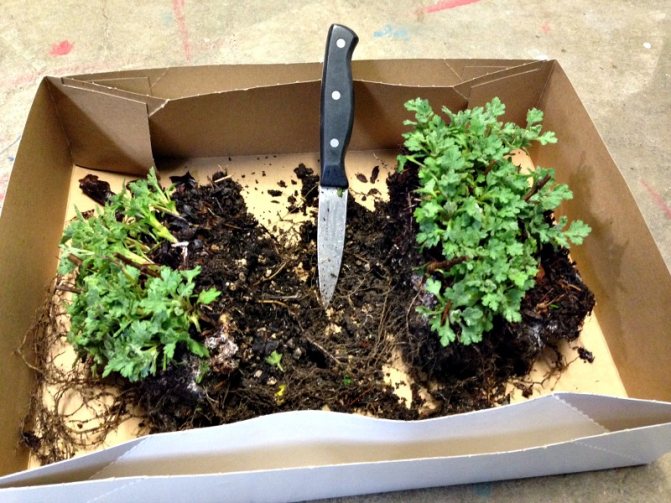

You can divide the multiflora bush with a sharp knife.
Then the cuttings are immediately planted either in open ground (weather permitting) or in a pot.
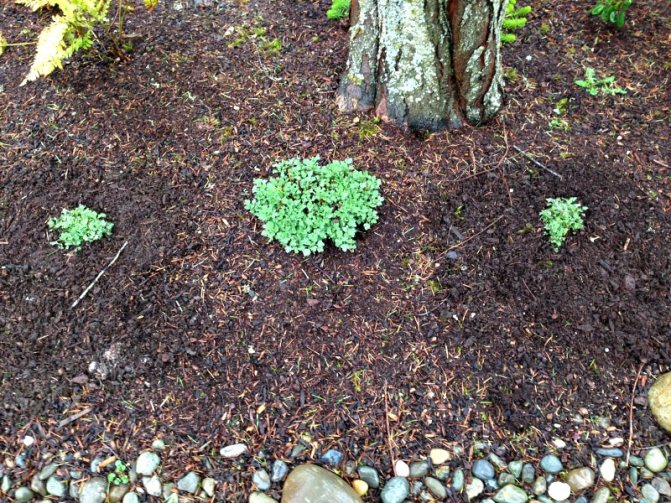

One mother bush can be divided into several young plants
The method of dividing the uterine bush of a spherical chrysanthemum is shown in the video plot:
Cuttings
Everything is simple here. When the stems grow on the mother liquor, cuttings 4-6 cm long are cut from them with a sharp knife or pruner. Both apical and middle cuttings are suitable - it does not matter. In any case, they can grow into a full-fledged plant and form a ball.
The lower leaves are cut off, otherwise they will be submerged in the ground or in water and will rot. Then the cutting is dipped in Kornevin (heteroauxin) and the lower internode is buried in the soil, poured into a plastic cup, cassette cell or other container.
You can also dip the cutting in Kornevin and put it in water. The spherical chrysanthemum takes root well in water. However, if you started cutting by cuttings in the fall or winter, that is, in cold weather, it is better to prefer rooting in the ground.
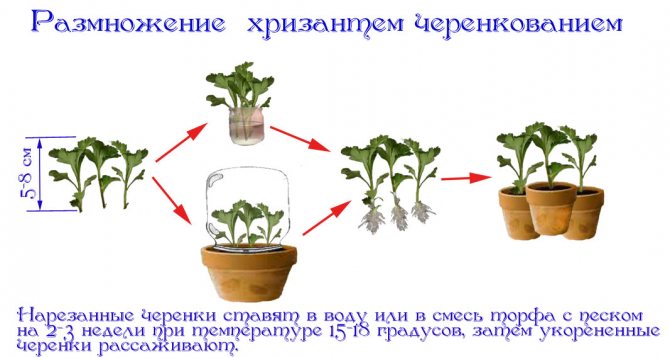

Depending on the temperature and season, the roots of multiflora cuttings appear on the 10-14th day.
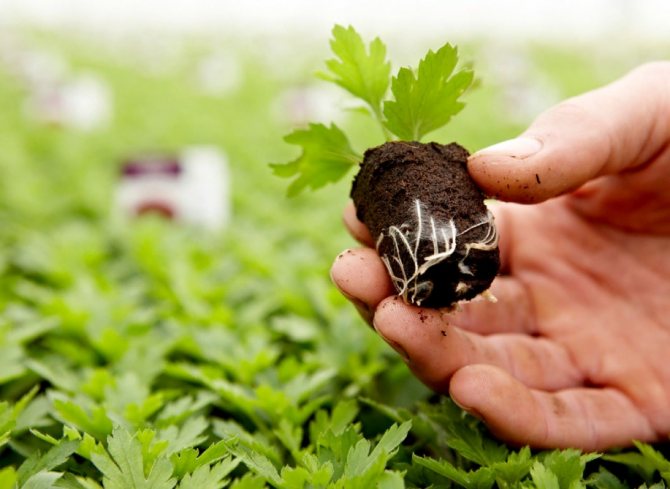

Chrysanthemum stalk gave roots in a peat tablet
Chrysanthemum multiflora cuttings are described in detail in the video:
How to cut
The best bushes are used for propagation by cuttings. They must be strong, free from signs of diseases and pests.
Timing
In spring, chrysanthemums are cuttings, depending on the timing of ripening, from March to May. The earlier the variety, the earlier the procedure is started. You can also remove cuttings and plant them in the ground throughout the summer. In the fall, the mother bush is dug up just before the frosts.
Cuttings in spring
For cuttings, strong, elastic shoots are chosen. Each cut cut should have 2-4 internodes. The lower part of the trunks is freed from the leaves. This is done so that the shoots do not rot during rooting. The remaining leaves are shortened by ⅓.
Harvesting mother liquors in the fall
In order for chrysanthemums to bloom profusely and effectively in the next season, you need to carefully choose mother plants. They must be well-rooted, healthy and strong. Bushes are dug up in the fall, before the onset of persistent frosts.
Storage of mother liquors in winter
Throughout the winter, you need to monitor the air temperature in the room. It should not rise above +4 ° С, otherwise shoots may appear prematurely. The humidity of the surrounding air is equally important. If the cellar is damp, the chrysanthemums do not need additional watering. The dried soil is slightly irrigated with water.
Planting and preparation of mother liquors
To prepare the uterine bush, the following procedures are carried out:
- at a height of 5 centimeters from the surface of the soil, the entire ground part of the bushes is cut off;
- chrysanthemums are dug up and placed in a bowl with a lump of earth;
- the root system is covered with sand.
The mother bush is placed in a cellar, where it will be stored until spring.
Summer cuttings of chrysanthemums
For summer cuttings, stems that have not yet had time to woody are chosen. The top is cut off with a height of 10-12 centimeters, which is planted in the shade. To prevent evaporation of moisture from the cutting, it can be covered with a glass jar. The seedlings are watered, and after 2-3 weeks, roots will begin to appear.
Important! A sharp, disinfected knife is used for grafting.
From the handle to the blooming ball
In order for the stalk to take root well and grow, it will be necessary to comply with the following conditions:
- Abundance of light - the place for growing plants should be well lit, the length of daylight hours - more than 14 hours.
- Temperature - about 20-22 ° С
- Timely watering - both waterlogging and drying of the substrate should not be allowed.
With good care, the stalk grows quickly. As mentioned earlier, the spherical chrysanthemum does not need to be pinched. But still, some growers believe that such a manipulation will not hurt, as it makes the bush denser. Accordingly, when it blooms, more buds will appear on it. If you agree with this position, then pinch the multiflora after 4-6 leaves appear.
It is possible to plant rooted cuttings in open ground after the end of the night frost. The sooner this is done, the larger the "ball" can grow by the fall. And the more gorgeous the bloom will be!
Chrysanthemums Korean multiflora groups are a real breakthrough in the field of plant breeding. They represent a perfectly even ball, strewn with flowers from the end of August-September so that sometimes the leaves are not visible. Inveterate flower lovers who "bring to the garden" all the newest and most interesting, they appeared several years ago. And their popularity immediately began to gain momentum. To date, many different varieties have been bred, with the exception of blue and blue cultivars.
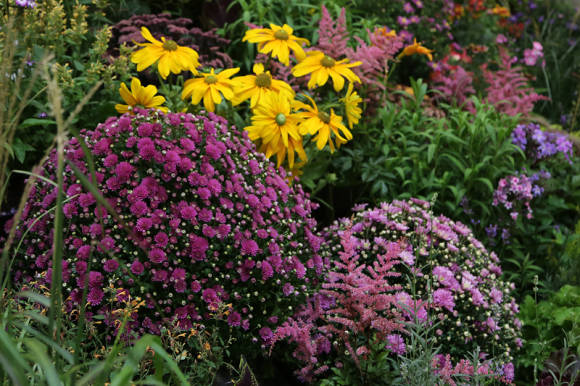

Landing
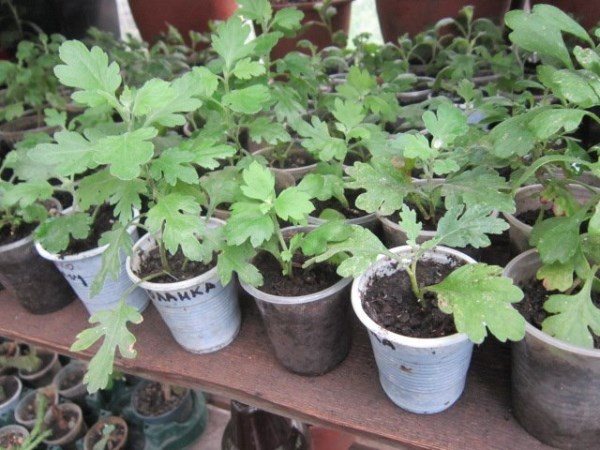

Instructions for planting rooted cuttings in a pot:
- Disinfect the bowl and all equipment that you will be working with.
- Ignite the prepared soil mixture.
- Pour a layer of drainage material into the prepared bowl.
- Pour soil over the drain.
- Remove the rooted stalk and plant it in a container, deepening it 3-4 cm.
- Moisten the soil and place the pot on the east or west window.
You can keep a chrysanthemum in a pot for as long as you like, if you take proper care of it. You can even get it to bloom right at home.
Variety to variety - discord
What is especially interesting is that these chrysanthemums turn into a blooming ball in just a few months - they grow from one small cutting, cut from the mother plant in February-March, and without any pinching. The ability to form an ideal spherical habit is genetically inherent in a plant. Moreover, they are more than appropriate in the garden even before flowering, because "spherical" is clearly traced in young chrysanthemums already in July. Well, all that they are capable of, the plants will be shown in September-October.
Read also Onion bamberger variety description planting and care
I will immediately make a reservation about the choice of a multiflora variety for my climatic zone. Early varieties, the flowering of which is "scheduled" at the end of August - the very beginning of September, should be bought by residents of central Russia and to the north, in order to have time to admire the flowering of plants in the ground before the real cold weather. But for the southern regions, medium and late varieties are suitable, because when early varieties bloom in their strip, they will burn out very quickly in the still active sun, and will not show their real color and stature. And September varieties will delight southerners until November.
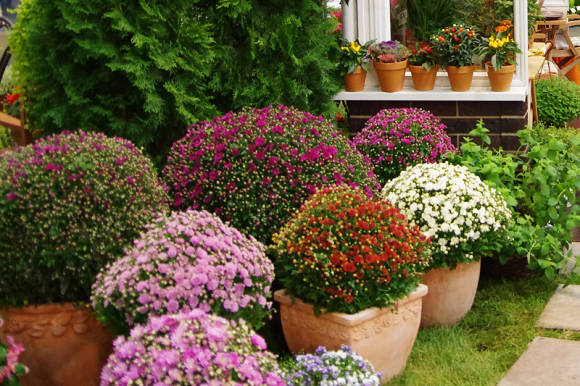

How to grow chrysanthemums from a bouquet of chrysanthemums
There are a lot of attempts at such a repetition of a vending look among flower growers. Of course, not all of them end in success, but in the overwhelming majority it is possible to grow new plants with all maternal traits. So, having wondered whether it is possible to grow a chrysanthemum from a bouquet, let us turn to the basics of botanical science. The main and only technique used to propagate and grow a flower from an existing cut plant is cuttings. Experienced growers note that cuttings of small-flowered Korean chrysanthemums take root more successfully and faster, although Indian specimens with large flower caps are propagated in the same way, with a little more effort and patience.
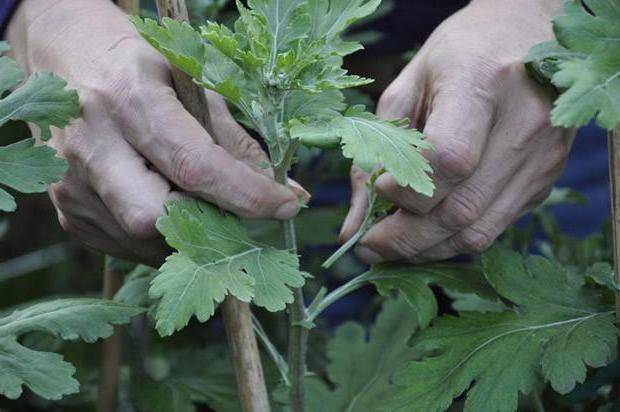

So, you can grow a new chrysanthemum from a bouquet of chrysanthemums, you just need to perform all the actions in the sequence that the grafting technology offers: the choice of viable cuttings, the correct preparation of the soil, the creation of conditions for germination and certain care necessary for the successful development of the plant.
Nuances of soil content
How big your blooming hemisphere grows depends on the time of planting in the ground. The earlier, the larger the diameter and height the ball will grow. In the southern regions, it is advisable to plant chrysanthemums in April, in the middle lane - in May, but still focusing on the weather. If the planting is delayed until mid-June, then the chrysanthemum will not gain the declared size and will bloom several weeks later.
Landing... When planting in a flower garden, along a garden path or as a curb, you need to maintain a distance of 50-70 cm between the plants. Yes, at first they will be small, and then, when they take root, they will grow by leaps and bounds.
The landing site must be very sunny. In the shadow of a perfect ball, it will not work - the plant will stretch out. And if in the southern regions the plant survives, if the sun's rays fall on it for at least half a day, then in the northern regions they should be illuminated by the sun all day.
Immediately after planting the cuttings in a loose, permeable soil, they should be shaded for a while until they take root. When planting, it is advisable to carefully roll over the root ball without disturbing the root system.
Top dressing... At the very beginning of the growing season, when the cuttings have just begun to grow, it is better to support the chrysanthemum with nitrogen fertilizers. Then, during the active growth of shoots in July - nitrogen-potassium. And only later, in the budding phase - phosphono-potassium.But never overfeed the plants! Fertilizer should be applied after watering or rain.
Watering... By the way, these chrysanthemums are very fond of "drinking". Due to the lack of moisture, the stems will untimely lignify and flowering will noticeably deteriorate.
How to grow a chrysanthemum from a cut of a bouquet: the optimal substrate
While the cuttings are treated with active substances, it is necessary to prepare the substrate. It should be breathable and loose. Different growers have different opinions on the composition of the soil. This could be:
- garden soil mixed with peat, sand and vermiculite in equal proportions;
- sod land mixed with leafy humus and river sand (1/1/2);
- pure perlite.
One of the soils presented is filled with containers for rooting cuttings: you can use large seedling boxes or immediately place the cuttings in separate small containers.
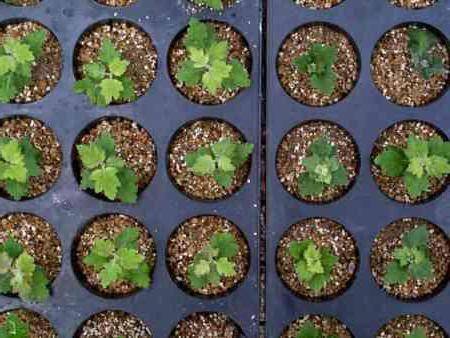

It is important to remember that their walls should not be transparent, especially if white perlite is used as a substrate, since root formation is noticeably faster in the dark.
Winter content
Shelter... Autumn will bring the inhabitants of central Russia and those who live to the north the eternal question - should multiflora be left to winter in the ground? In settlements south of the Moscow region, this chrysanthemum can overwinter under a good air-dry shelter. But what is especially important - if it is planned to shelter the mother liquor, then it should be planted in a place where water does not stagnate. Chrysanthemum easily dies from getting wet. But keep in mind that a bush over 3 years old will no longer give an ideal shape, it will fall apart, or even begin to rot.
Storage of mother liquors... In regions with a harsh climate, it is necessary to dig up multiflora annually, keep the mother plants in the cellar, basement, veranda, warmed logs at low positive temperatures of + 2-4 ° C in winter (even if the earthen lump freezes a little, it is not scary), and cuttings should be carried out in early spring. Each stalk will give rise to a blooming ball in the current season.
In order to do this procedure with the least labor costs, even in September, before frost, the mother plants of chrysanthemums can be transplanted from open ground into large pots and left to bloom outside. Do not shake off the soil from the roots during transplantation. If there is a threat of frost, the plants should be transferred to a greenhouse or other bright, cool room. They will delight with flowering indoors for a long time.
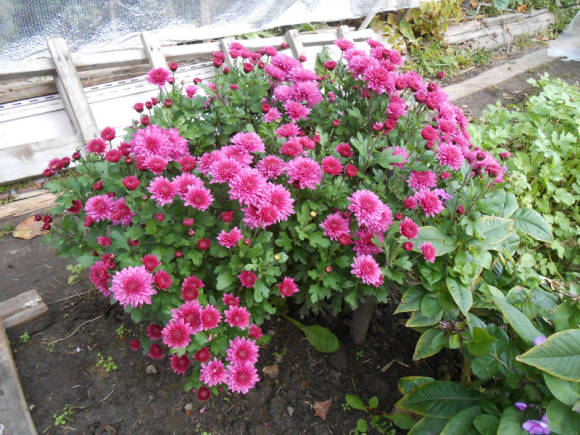

Then the above-ground part must be shortened to 8-10 centimeters and the mother plant must be removed directly in the pot for storage.
author Butrimova S.V., photo by the author
Chrysanthemum multiflora (spherical chrysanthemum), characterized by long and abundant flowering, has gained immense popularity among flower growers in recent years.
Having appreciated all the advantages of a spherical chrysanthemum, many gardeners strive to acquire rooted cuttings of multiflora in the spring for a bright decoration of their garden in late summer and autumn. Often, varietal planting material of spherical chrysanthemums is ordered via the Internet, then a parcel with seedlings is received by mail.
I would like to share with the lovers of this wonderful plant some tips for the successful cultivation, reproduction and wintering of a globular chrysanthemum. This article is based on questions about the cultivation of chrysanthemum multiflora, which are most often asked by flower growers.
I must say right away that my advice is not mandatory, but purely recommendatory. Since each grower has accumulated his own experience of growing chrysanthemums in his garden with certain climatic conditions and distinctive features of the soil; there are different physical and financial capabilities.
Using layering
This breeding method is good for winter-hardy varieties or homemade chrysanthemums. Reproduction by layering is carried out by dropping the stem.
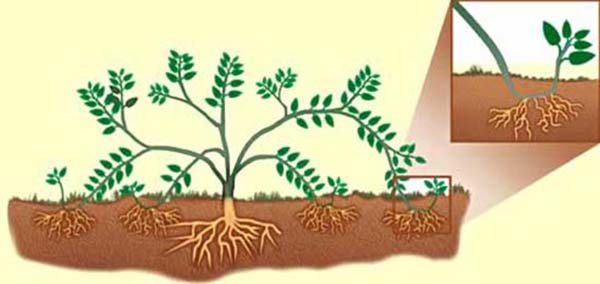

Reproduction of chrysanthemums by layering
It is best to carry out the procedure in the autumn.A groove is dug next to the bush, corresponding in terms of width and depth to the dimensions of the bush itself. The stem is placed on the bottom of the groove and pinned with a clip. Sprinkle on top of 20 centimeters with loose soil. In this form, it is left for the winter.
In the spring it will be possible to see how young shoots have appeared, having their own root system. After the frost retreats, the earth is raked and the stem is divided into parts so that each one has strong and developed roots. After each part cut off from the stem - the shoot - can be planted where it will grow constantly.
Care of seedlings of spherical chrysanthemum after postage
Having received the long-awaited parcel with spherical chrysanthemum seedlings, which have been on the way for several days, you need to immediately unpack the parcel and take proper care of the plants.
It is important that before planting in the garden, chrysanthemum seedlings quickly come to their senses after a long shipment in the absence of light and fresh air. After all, for cuttings sent by mail, this is undoubted stress: from a bright and warm greenhouse to get into a dark box for several days, and then abruptly - under the sun, under the breeze and into the cool night garden.
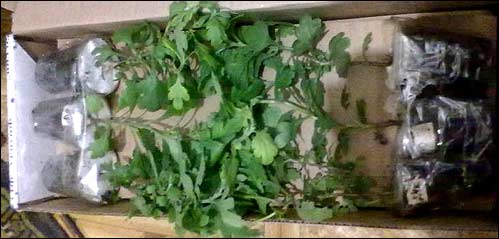

In the photo: cuttings of multiflora chrysanthemum packed in a parcel box
After unpacking the cuttings of the multifor chrysanthemum, it is advisable to hold the seedlings outside in partial shade for a couple of days so that the plants adapt to the new conditions. If possible, in the morning and in the evening, it is advisable to spray seedlings of spherical chrysanthemum for 4-5 days (with Epin or Zircon solution).
When planting spherical chrysanthemum seedlings in open ground, do not forget to build shading for them for the first time, as is done for any planted seedlings. Alternatively, use old, bottomless buckets or other similar temporary shelters to shade the planted plants and protect them from the wind - at least for a week, until the chrysanthemum seedlings take root.
Testimonials
I have never used rooting stimulants for cuttings, the roots grow back anyway, even in capricious varieties of chrysanthemums. I take water that is settled or thawed, sometimes rainwater. She cut out old, degenerating bushes, the offspring repeated varietal characteristics, it turns out in this way even a lost flower can be preserved. Familiar from the northern regions (where winters are usually snowless, chrysanthemums freeze out) save flowers by harvesting a mother bush with subsequent cuttings.
When I propagated a spherical chrysanthemum, after rooting and transplanting into a container, buds formed on the cuttings, about a month remained before planting in a permanent place. I thought for a long time what to do with them, in the end I transferred some of the bushes to the greenhouse, left the rest at home and cut off the inflorescences. Those that were in the apartment became lush and large, and the flowering ones noticeably weakened, but after landing in open ground, they quickly caught up with other bushes.
Reproduction of chrysanthemum by cuttings in the fall will not take a lot of effort, even a novice florist can handle this breeding method. Carefully study our recommendations and feel free to get down to business. If you correctly organize a flower bed with different varieties of chrysanthemums, you can create an island that blooms magnificently from spring to late autumn, until the ground is seized by severe frosts. How can you deny yourself such a pleasure!
Chrysanthemums must be loved. They are gentle, beautiful, fluffy. At the same time, they bloom when there is practically nothing green and living in nature. For this, these flowers are appreciated. Planting them is very easy. This can be done even using cuttings from a bouquet. Thus, spherical chrysanthemums are often rooted, they are propagated by cuttings in order to preserve the signs of varietality. If you didn't know about this, read our article and try yourself as a florist. Here we will write about how to breed chrysanthemums at home.


Planting and pinching of multiflora chrysanthemum seedlings
In chrysanthemum multiflora, the shape of a bush in the form of a ball is genetically laid down, therefore it will form without pinching the seedling. But, due to the fact that it is not always possible to plant a multiflora chrysanthemum stalk in open ground immediately after rooting, it often outgrows and stretches. And then, in this case, a single pinching of the long shoot of the chrysanthemum will contribute to a faster and easier formation of a spherical multiflora bush.
In some varieties of chrysanthemum multiflora, some of the rooted cuttings begin to bush independently on the crown even before they are planted in the ground. In this case, I advise you to slightly deepen the stalk of the chrysanthemum when planting (before the branching of the main shoot begins).
For clarity, I present below three photographs of rooted cuttings of multiflora in order to orient flower growers in different situations with chrysanthemum seedlings: - the cuttings in the first photo are of normal size, when planting it can not be buried or pinched; - it is advisable to cut the long stalk in the second photo from above (to the level shown by the hand); - in the third photo, the stalk, which has begun to bush at the top of the head, can be deepened during planting (to the level shown by the hand).


In the photo: different situations with chrysanthemum seedlings
Choose a spacious, open, sunny place for growing spherical chrysanthemums, where they will form dense, beautiful bushes-"balls" and bloom very profusely.
It is necessary to plant multiflora chrysanthemum seedlings in the ground at a distance of 50-80 cm from each other, taking into account the formation of wide bushes.
Read also Momordica beneficial properties and uses
Chrysanthemums love light nutritious soil, so when planting multiflora seedlings, I recommend adding a mixture of humus and peat to the holes.
What flowers are suitable for rooting
Although the chrysanthemum is easy to root without much effort, you need to carefully choose the material for the propagation of flowers. The following requirements are imposed on it:
- There should be no signs of rot on the stems.
- Cuttings should be strong and healthy looking.
- Shoots should not be old or young: cuttings of medium thickness and hardness take root best.
The best choice is cuttings with lateral ramifications. They take root faster than others. But do not harvest them from weak, sick, young and too old bushes. They do not have enough strength to put down roots, and if they do, they will most likely rot after landing in the ground: save time and energy.
Benefits of planting chrysanthemum multiflora seedlings in pots
For those gardeners who have many different flowers growing on their flower beds, including heat-loving summer plants, the option of planting multifor chrysanthemum seedlings in pots is very convenient.
Plant multiflora seedlings one plant at a time in large pots (3.5-5 liters) with drainage holes at the bottom. Then these pots with spherical chrysanthemum seedlings MUST BE BURLED into the ground. This will save potted plants from adverse natural factors (from overheating in summer, from overturning by the wind, etc.).
Planting multiflora chrysanthemum seedlings in pots is convenient and rational for several reasons. Firstly, while the chrysanthemum seedlings are still small and insufficiently decorative, you can temporarily dig in pots with developing bushes, first not in the front place of flower beds, but somewhere on the sidelines or in the garden, where the young plants will be spacious and sunny. Then, closer to autumn, when the multiflora chrysanthemum already forms a beautiful spherical crown and is completely covered with buds, preparing to bloom, it is time to dig up the pots with spectacular plants and move them to a prominent place in the garden. For example, dig in flower beds in the foreground instead of fading summer beds.At the same time, such a movement of pots with chrysanthemums to a new place will be completely painless for flowering bushes.
Secondly, the advantage of planting multiflora seedlings in pots is that for a small pot volume, it is not difficult to prepare a nutritious and light substrate with the addition of perlite or vermiculite.
Thirdly, the multiflora chrysanthemum bushes growing in pots will not need to be dug out of open ground in the fall and transplanted - before lowering the plants to the basement for the winter. It will be enough just to remove from the flower beds and transfer the pots with treated chrysanthemum queen cells to the right place.
Necessary conditions for the growth of chrysanthemums
Growing chrysanthemums in the garden requires compliance with certain conditions of detention. Let's find out what this flower loves.
Lighting and location
Chrysanthemums love a lot of light, but do not tolerate the scorching rays of the sun at lunchtime. Therefore, it is best to plant flowers in a place where the shadow falls at noon (near the wall of the house, near the fence, near a tree or shrub). The optimal location is east.
Temperature
In summer, chrysanthemums prefer to grow at a temperature of + 20 ... + 23 ° C. They winter well: flowers can tolerate frosts down to -28 ° C. But since it can be colder in Russia in winter, it is better to cover the flowerbed with a heap of leaves or peat.
Air and humidity
Chrysanthemums love moderately humid air (50-70%). Waterlogging can lead to the development of fungal infections. A lack of moisture in the air can cause pests to damage flowers and dry out its leaves and flowers. It is better to plant chrysanthemums in a place protected from drafts.
Features of the development of the multiflora chrysanthemum bush
Chrysanthemum multiflora begins to build up the bulk of its spherical bush only from mid-July, and until that time the growth of shoots is small. Florists who grow multiflora for the first time are very worried about its slow development in the first half of summer - they think that such small bushes will be in the globular chrysanthemum in the fall.
However, in August it is no longer possible to recognize the grown and prettier multiflora chrysanthemum, which becomes very decorative even without flowers. By September, she has fully formed a full-fledged spherical bush, and this miracle is formed from just a single small cuttings planted in spring!
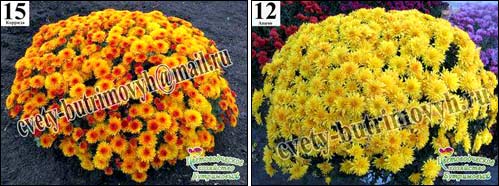

In the photo: multiflora chrysanthemums of the varieties "Corrida" and "Apacho"
How to propagate chrysanthemums in the fall from a cuttings taken from a bush
How to propagate chrysanthemum by cuttings in the fall? This is done very easily, and the survival rate of plants planted in this way reaches almost 100 percent. To do this, you need to choose a bush that will be uterine. On it, it is necessary to cut off all the shoots almost at the root. After that, you can fertilize the chrysanthemum with nitrogen fertilization. Some time after this, basal shoots will appear on the plant. You need to wait until they grow about 8 centimeters. When this happens, dig up the chrysanthemum bush and bring it into the greenhouse. Most likely it will be after the first frost. Then divide it into cuttings. You will have approximately 20-25 shoots. When separating cuttings, pick them out along with the root.
Sometimes, after grafting, the roots of the mother plant remain. Do not rush to throw them away. Better to water and wait a while. The bush can sprout again, which you can also use on cuttings.
For planting, select branches of medium hardness, since soft ones risk rotting, and woody ones will be taken for a very long time. Also, make sure that the cuttings have 4 leaves. It is these branches that have a better chance of rooting.
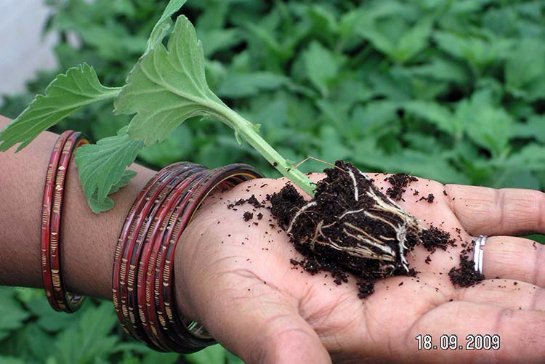

Globular Chrysanthemum Care
In the process of growth, the spherical chrysanthemum is very responsive to feeding. At the same time, do not forget to alternate root dressing of chrysanthemum and foliar (spraying on the leaves).
Since spring, chrysanthemum multiflora should be fed with complex fertilizers with a predominance of nitrogen, which contributes to the formation of a branched strong bush.
In summer, for a better development of chrysanthemums, it is advisable to use complex fertilizers, in which, in addition to the main components, there are microelements (for example, "Master", "Fertika", "Bona Forte for roses and chrysanthemums", various humates, etc.).
Closer to the budding period, an adult chrysanthemum requires phosphorus-potassium fertilizers (for example, potassium humate). By the way, spraying multiflora flowering bushes with a solution of potassium humate gives its flowers a richer, richer color.
Landing technology
The filled containers are well moistened with warm settled water and the cuttings are placed in the substrate: one at a time in separate containers and at intervals of 5-6 cm in seedling boxes. When planting prepared shoots, do not forget that the cuttings should not come into contact with each other. This will reduce the possibility of fungal infections, since at this time, in conditions of high humidity, plants are most vulnerable. Containers with cuttings can be covered with a film covering, providing an optimal microclimate. For successful rooting, the temperature regime is important: the containers do not need to be placed close to the heat sources, the optimal room temperature for the formation of roots is 18-20˚С. Since the question of how to grow chrysanthemums from a bouquet does not end with planting a cutting, let's move on to the main caring activities necessary for the success in the revival of the culture we like.
Wintering of the mother plant of chrysanthemum multiflora
In regions with cold winters, chrysanthemum multiflora winters in a cool room or in a garden under an air-dry shelter.
When wintering a globular chrysanthemum indoors, it is important to ensure that the basement or cellar is not too damp. It is also important that the soil with the roots of the mother plant of the chrysanthemum does not dry out completely (if necessary, place a handful of snow on the substrate in a box or in a pot with a wintering chrysanthemum).
It is necessary to lower into the basement the uterine bushes of chrysanthemum multiflora properly prepared for wintering: - with cut off shoots (up to a height of 10 cm) and then peeled from leaves; - with ALWAYS DRY remnants of shoots.
When wintering chrysanthemum multiflora in open ground under an air-dry shelter, the bushes are preliminarily prepared in the same way: they are cut and cleaned of old foliage so as not to create conditions for the development of rot.
The choice of the option for wintering a spherical chrysanthemum under an air-dry shelter must be carried out taking into account the climate of the region of your garden, taking into account the characteristics of the terrain and the microclimate of the garden. For example, if melt water does not leave your site for a long time in spring, then the option of wintering multiflora in the garden is unacceptable.
There are many options for constructing an air-dry shelter for wintering plants. The choice of the appropriate option depends mainly on your physical, technical and financial capabilities. Various options for arranging an air-dry shelter for chrysanthemums can be viewed on the Internet by typing in a search engine "examples of an air-dry shelter for plants."
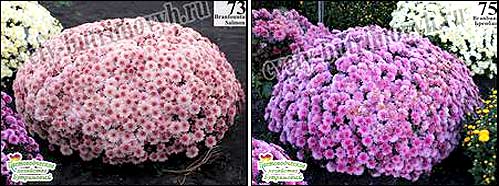

In the photo: chrysanthemums of multiflora varieties "Branfontaine Salmon" and "Brenbanni"
Reproduction of bouquet chrysanthemums
The flower is usually cut in October-November, but is it possible to carry out the procedure at any other time of the year if you were presented with a bouquet of gorgeous chrysanthemums of a rare, incredibly beautiful variety? It is possible, because cuttings from bouquet flowers not only root well, but also repeat varietal characteristics. Of course, you can search for your favorite variety in catalogs, order seeds or seedlings. The search will take time and financial costs, but why, if the planting material is already at hand.
How to choose a flower and what to do with it
All inflorescences, as well as the bottom of the cutting (about 4 cm) must be cut off.Remove all leaves and side branches from the remaining stem, cut not directly at the stem, leave small stumps. Put the stalk in settled or boiled water, add a little root stimulant and a tablet of activated carbon, it will kill microorganisms that provoke the development of various putrefactive processes.
The roots will hatch in about 3-4 weeks, if they have not appeared, and the cutting has begun to rot, cut the lower part of the stem to healthy tissue, rinse the glass thoroughly, replace the water and add activated charcoal again. As soon as the roots appear, the chrysanthemum must be immediately transplanted into a pot of soil. Do not worry if the stem begins to dry out, this is not a sign of spoilage.
Preparation of containers and soil
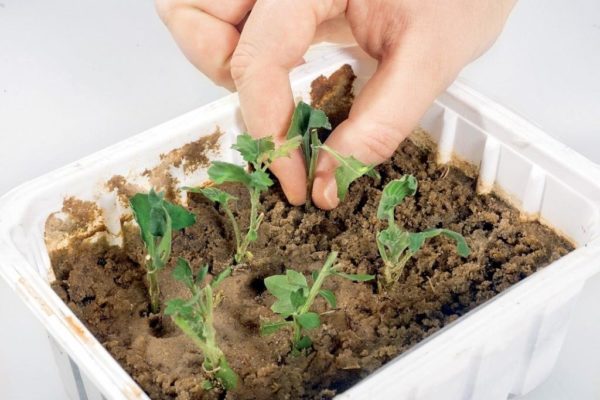

For only rooted cuttings, you should choose small pots, they may not be deep, but always wide. In such a container, the chrysanthemum root will occupy a new area gradually, there will be no accumulation of excess moisture in unaffected areas of the soil, which means that the risk of decay or the appearance of pests will be minimized. It is necessary to transplant a flower into a large flowerpot when it grows well.
Chrysanthemums prefer loose, nutritious soil, poor, dense or heavy soil is not suitable for them. If you do not have the opportunity to purchase special soil for chrysanthemums, prepare it yourself. Mix commercially available potting, gardening, and gardening soil with perlite, sand, and coconut fiber. Adjust the amount of ingredients to your liking for a light and loose mixture.
Planting and caring for a rooted chrysanthemum


Plant the cuttings very carefully so as not to damage the roots. Pour the soil into the prepared container up to half the volume, moisten it a little, place a twig in the middle and gradually cover it with earth. Lightly apply the soil and water again with a little water. At first, it is better not to touch the chrysanthemum, cover the stalk with a jar or plastic, periodically moisten the ground.
After a month, the seedlings can be fed with nitrogen fertilizers (a tablespoon of dry raw materials per 10 liters of water), they activate growth. The lightest window sill should be allocated to the young bush, in the spring the seedling should be shaded from the sun's rays. When the cutting takes root and actively grows, pinch the top a little, the plant will start up side shoots, after 2 months, re-prune. At first, the chrysanthemum needs light even in winter; after planting in open ground, the flower adapts and begins to move into a dormant stage.
About limited watering of the overwintered mother plant of chrysanthemum
I want to draw your attention to a common mistake with excessive watering, which many growers make when they take out multiflora mother liquors from the basement in the spring, which are already beginning to germinate.
The mistake lies in the fact that overwintered chrysanthemum bushes begin to water abundantly after storage. This often leads to the death of multiflora from rhizome sticking.
To prevent this from happening, you need to water the uterine chrysanthemum bushes only after the earth has completely dried out. And at the same time, do not spill the entire earthen lump, but take literally half a cup of water and splash it over the surface of the substrate in the pot.
Preparing cuttings
In order to grow a chrysanthemum from a bouquet at home, it is necessary to properly cut and prepare cuttings, which are considered the basis for future success. To begin with, the stem of the plant you like must be carefully examined, choose the strongest side shoots, that is, those growing from the leaf axils, shoots. Viable are "sides", located up to flower stems, ending in inflorescences and practically without leaves. Stem cuttings are also used for propagation, cutting them into 10-12 cm each. They are carefully cut green with a sharp knife.You can break them out, but so that the stalk ends in a "heel" - a piece of the mother's stem.
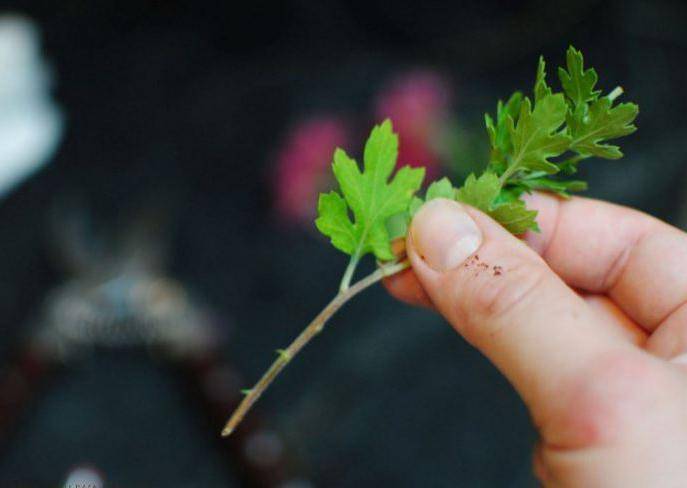

On the shoot, all the buds and leaves are removed, leaving only 2-3 upper ones, which can also be shortened by a third. They do this in order to stimulate the development of roots, and not a set of green mass, which will inevitably destroy the cutting.
Cuttings prepared in this way are placed for 3-4 hours in a solution of any phytohormone-stimulator ("Kornevin" or "Heteroauxin"), the concentration of which may slightly exceed the recommended one in the annotation to the preparations.
Reproduction of chrysanthemum multiflora
In the overwintered chrysanthemum multiflora, young shoots grow from the rhizome. They can be simply separated from the rhizome and planted for rooting in an individual pot (one shoot at a time). Alternatively, you can wait until the multiflora shoots grow up, and then handwritten them.
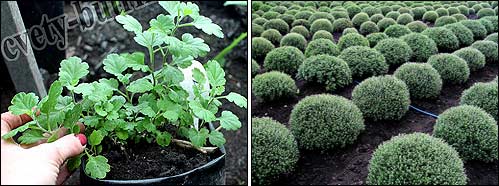

In the photo: from a single rooted cuttings from the mother plant of chrysanthemum multiflora by the end of summer, a spherical bush grows, completely covered with buds
Cutting chrysanthemums is not difficult. I cut the cuttings from the uterine bush, remove the lower leaves from them. I powder the cuttings with Kornevin, or put them in Kornevin's solution, or dip them in Clonex Gel. Then I plant the multiflora cuttings prepared in this way one by one in disposable plastic cups filled with a light and loose substrate. You can also plant chrysanthemum cuttings for rooting in peat or coconut tablets (in tablets, the rooting of cuttings goes very well).
It remains to create a greenhouse effect for the planted chrysanthemum cuttings for successful and quick rooting. Then, 2-3 times a day, I spray the planted cuttings with a rooting stimulant - Epin, Energen or some similar preparation.
Perhaps to someone it may seem difficult to reproduce and grow chrysanthemum multiflora. In fact, these processes are not labor intensive. On the contrary, caring for a chrysanthemum is not difficult, it is very simple and interesting. And admiring blooming spherical chrysanthemums is a lot of pleasure!
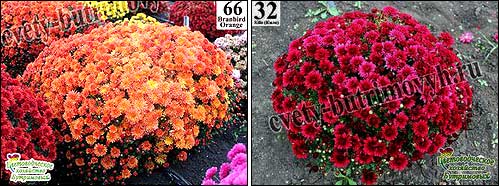

In the photo: Branbed Orange and Kilo multiflora chrysanthemums
Purchase spherical chrysanthemum seedlings of the desired varieties with a variety of flower colors for your garden. And then your garden will be colored with bright, abundantly flowering bushes of multiflora chrysanthemums until late autumn!
Svetlana Vladimirovna Butrimova (Voronezh region, words of Saguna)
Every week, for 10 years, for our 100,000 subscribers, an excellent selection of relevant materials about flowers and garden, as well as other useful information.
Care rules
Caring for chrysanthemums is to create high humidity for quick rooting of cuttings, watering, picking, feeding.
Temperature regime
A box with landings is placed in a room with a temperature of 15-18 ° C. In a warmer place, cuttings will root faster, but there is a greater chance that they will rot. The room should be well lit. With a lack of light, the plantings are illuminated artificially.
See also
Medicinal properties and contraindications of rhododendron, use in folk medicineRead
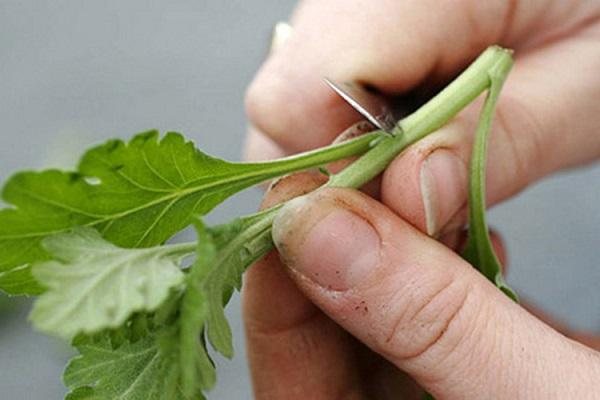

Humidity
Plantings require high humidity for rooting. To increase it, the box with cuttings is covered with foil. It should cover the seedlings in such a way that air does not penetrate to them from the sides. Remove the film after the formation of roots on the cuttings.
Moistening the substrate
When chrysanthemums are kept under the film, they do not need frequent watering. Care should be taken to keep the soil moist, but not wet. Excess moisture can provoke fungal diseases.
After rooting
When the cuttings begin to grow, it means that they have taken root, and their development has begun. So that they do not interfere with each other, a pick is made: a distance of 8 centimeters is left between the plants.Excess bushes can be rooted by planting them in separate containers. Further care consists in watering, feeding once a week with mineral fertilizers.
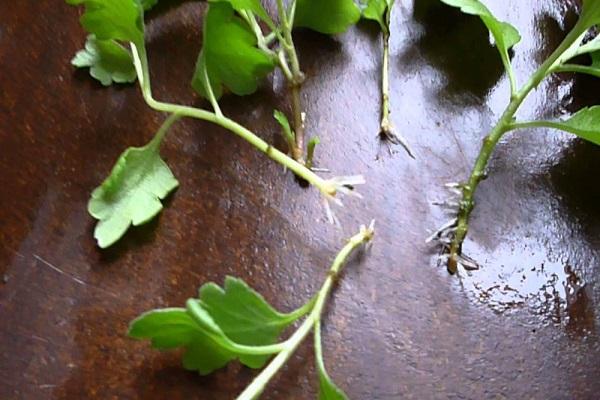

Cutting process
Let's consider step by step how to properly cut a bush growing in the ground:
- A knife for cutting cuttings must be disinfected so as not to infect an infection.
- The lower leaf should be removed from the cutting so that it does not rot, as well as flowers or buds (if any). At least 2-3 leaves should remain on the stem.
- During winter or spring reproduction, the sprout should be placed in water for a day with a rooting agent dissolved according to the instructions, powdered with Kornevin or a mixture of talcum powder (1 mg) with growth stimulants NAA, BCI or IAA (3–6 mg). In summer, this item can be skipped.
- The prepared cutting is planted in the substrate.
Possible options:
- pure peat or peat pellet;
- perlite;
- peat, sand and sod land (1: 1: 1);
- sand, turf and leafy land (1: 2: 1).
The thickness of such a substrate should be at least 12 cm. An additional 1–2 cm of clean sand or a mixture of sand and peat (1: 1) is poured on top. The shoot must be planted in the ground to a depth of 1.5 cm. The recess for the cutting is preliminarily made with a peg. If you are planting several shoots at once, the distance between them should be 5–6 cm. In the spring, the planting container should be kept at home, in the summer you can take it outside or plant the seedlings directly into the open ground.
Now let's look at how to root a chrysanthemum stalk from a bouquet. From the selected branches, you need to cut off flowers and buds, as well as side shoots, if any. Pour filtered or settled water into a small glass. It is advisable to add to it "Kornevin" or another growth stimulant, as well as activated carbon, which will reduce the risk of decay.
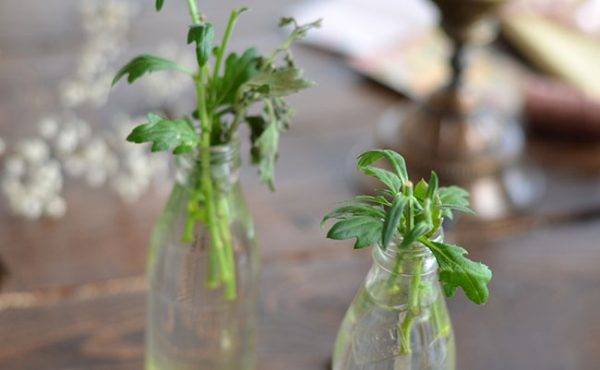

When growing a seedling in water, it must be periodically inspected. If the lower part begins to rot, it is cut to a healthy place, and the water is changed. The sprout is transplanted into the ground after the roots appear, about a month later. A hydrogel is sometimes used instead of water. In this case, it is recommended to spray the sprouts periodically.
Features of winter storage
The soil in the pot should not be allowed to dry out, therefore, moderate watering is the main condition for winter storage, but overflow is fraught with harmful consequences.
The flower can rot and die, so watering should be carried out only after the soil is completely dry. If the room where the chrysanthemum is stored is rather humid, you do not need to water the plant.
Timing and order of harvesting cuttings
In March, you can start cutting chrysanthemums. About 14 days before the transplanting process, the queen cell should be transferred to a warm room, this will stimulate the formation of young shoots. During this very period, abundant watering is required, so the flower can form massive stems.
After the shoots grow 10 cm and leaves grow on each of them, you can start grafting. In this case, the lower leaves are removed, and those that are located on top should be left intact.
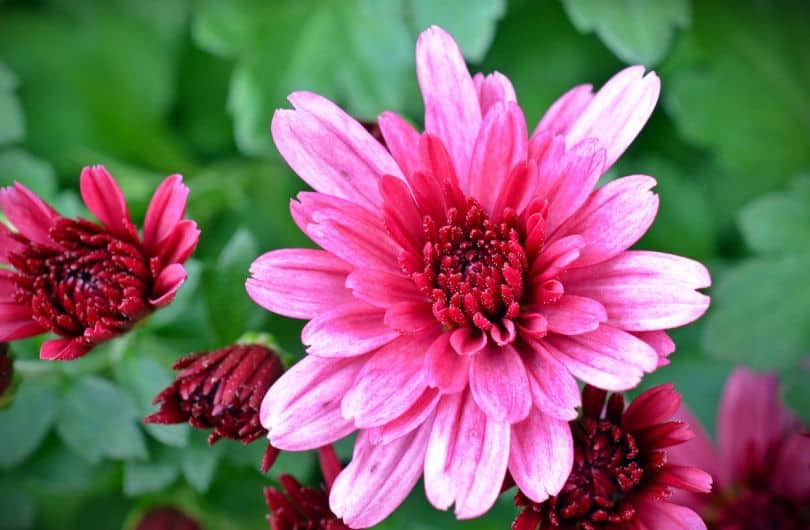

Planting cuttings
A certain amount of settled water is poured into the soil prepared in advance, then holes are made, the distance between which should correspond to 6 cm.Each stalk is planted to a depth of two centimeters, if it is more, their decay may occur.
Florists often plant cuttings in separate cups, in some cases several pieces in one pot at once. The latter method makes it possible to obtain a more lush bush.
For better rooting of chrysanthemums at home, you should create a microclimate using glass or plastic wrap. So you will be able to observe the process taking place in the containers and track all negative processes.
If you are propagating chrysanthemum in greenhouse conditions, you do not need to cover the cuttings.
How to care for cuttings
For successful rooting, many gardeners use a remedy such as Kornevin. It stimulates the formation of roots, it is used before planting. However, you can achieve good survival rate without it, it is enough to provide the cuttings with certain conditions:
- Temperature not lower than +17 and not higher than +19 degrees
- Irrigate the plants every day with a spray bottle.
Covering material should be removed only after you see new leaves, this is a sign that the roots have formed and the plant has begun to grow. A couple of weeks after that, you can feed the seedlings with a mineral complex according to the instructions. Loosening and spraying will help the roots and the ground part of the flower develop quickly.
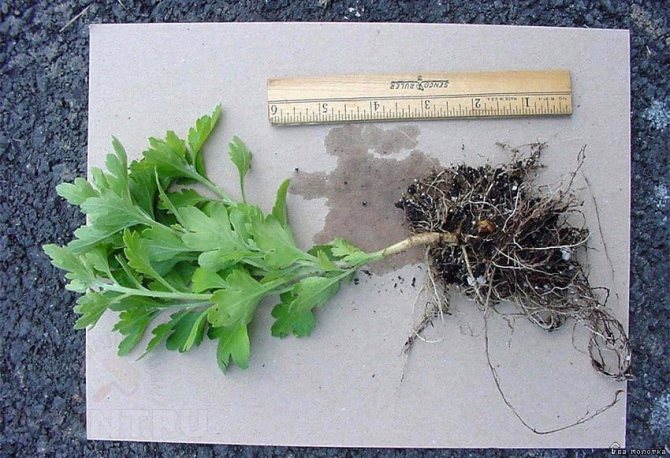

Tips, recommendations
Experienced gardeners and florists give the following tips:
- To prevent the cuttings from rotting when rooting in water, if you can forget to change the water, add 1 tablet of activated charcoal to the jar. It will inhibit the development of putrefactive processes.
- If the chrysanthemum itself has given roots, standing for a long time in a vase, then it can be planted in a pot or open ground right in its entirety.
- When planting a whole bush (not small cuttings) in the ground, pruning is required to stimulate the growth of the root system and the aerial part of the plant. To do this, you need to cut off the main shoot, leaving 4-5 sheets. New branches will be formed from them.
- If a rooted stalk forms buds, remove them without mercy. The plant needs strength to adapt to a new place and form a bush. A chrysanthemum will be frail if allowed to bloom in the first year after rooting.
- An opaque container (ceramic mug, plastic container) will help speed up the process of root growth. Rooting is better in the dark.
- If you decide to breed chrysanthemums from a bouquet in the open field, then for the winter you will still have to dig out the first years, placing them in large pots and sending them to the basement for the winter. The first frosts for young flowers that have not yet had time to harden can become destructive.
- When transplanting an adult chrysanthemum from a pot into open ground, removing the bush by cutting the container will help to avoid damage to the root system. Therefore, it will be good if the flower grew in a plastic container.
Breeding chrysanthemums by rooting cuttings obtained from a bouquet is not difficult. Therefore, you can handle it for sure. Rooting of flowers often happens on their own, by chance. But if you put in even a little effort, then be sure to get a personal chrysanthemum bush in the garden. Watch the video on how to root cuttings correctly.
Cuttings are the main method of propagation of chrysanthemums. Moreover, not only cuttings cut from the bush, but also the stems of flowers from the presented bouquet, lend themselves to rooting. The process of rooting shoots is not particularly difficult, so even a novice florist can easily cope with it. To get a luxurious flowering bush after a while, it is enough to learn how to root a chrysanthemum from a bouquet and make a little effort.
Plant decoration
For the formation of a bush of the correct shape and the formation of flowers, it is correlated with varietal characteristics, the tops of the central buds and lateral shoots of plants must be pinched in a timely manner.
For large-flowered varieties - pinch the top of the central shoot with the appearance of 8 leaves, after which lateral shoots develop, of which 2-3 strong ones are left, and the rest are removed. Grasshopping is done as needed 1-2 times a week to form one large flower on each stem.


For small-flowered plants - the top is pinched with the appearance of 4-6 leaves, after which new shoots are formed, the pinching of which is carried out in the presence of 8 or more leaves. After re-pinching, many new shoots appear, as a result of which the chrysanthemum bush acquires splendor.


Periodic pinching affects not only the formation of the bush, but also the development of the plant as a whole, since the stepsons only draw a large amount of nutrients from the bush.
Thus, the reproduction of chrysanthemums can be done not only in the presence of a bush growing in the garden, but also from a donated bouquet, and the whole process is shown more clearly in the video - the reproduction of chrysanthemums.
gid-
Spring cuttings
Spring cuttings are the most popular breeding method. Gardeners joke that in the spring it is enough to stick a branch into the ground for it to take root. Plants at this time come out of deep dormancy. Growth processes are enhanced in them.
If you have never managed to root any indoor or garden flower, you need to try to do it in early spring, when the buds are just awakening, - the chances of success will immediately increase.
In the spring, at home, cuttings are cuttings (selected for reproduction of plants) of chrysanthemums, dug in the fall in the open field and dug in the cellar for the winter. They are brought into the warmth. Young shoots immediately begin to appear from the roots, from which the planting material is cut. Also in the spring you can cut indoor varieties.
At the bottom of the cups, you need to pour fertile soil, and on top place a layer of peat, pure perlite or a mixture of garden soil with sand in a 1: 1 ratio. The thickness of the sand layer is 2-3 cm, the total thickness of the substrate layer is at least 10 cm.
The mother plant needs to be prepared in the fall. For this:
- 1. In late autumn, with the onset of the first frost, all chrysanthemums growing in the garden are cut off all the shoots to the ground.
- 2. The roots are dug out with a lump and placed in a bucket, basin, large pot - any dish of suitable size.
- 3. Plants are lightly sprinkled with earth or sand and placed in a cold cellar or any room with a temperature no higher than +7 degrees. At a higher temperature, chrysanthemums do not overwinter, since shoots will appear from the roots right in the cellar.
The soil in the container should be slightly damp. In a damp cellar, watering is not required, but if the soil is dry, it needs to be moistened from time to time, since the overdried plant will die.
Cuttings start in March. For this:
- 1. In mid-February, the mother plant is transferred to an apartment and watered well.
- 2. Young shoots will appear in a week. When they grow 8-10 cm, they are cut off, leaving two pairs of leaves on the stumps. Younger shoots should not be cut off, since they have not matured and will rot instead of rooting. From the stumps remaining on the mother liquor, new shoots will soon appear, which can also be used as material for cuttings.
- 3. Remove the lower pair of leaves from cuttings, leaving only the upper one.
- 4. Cuttings are planted in pots of 1-3 pieces or in a common cuticle at a distance of 5 cm. The substrate should be light, breathable and water-permeable.
- 5. Previously, the soil is spilled with water. Planting depth - 1.5-2 cm.
- 6. If the cuttings are carried out in the room, cover the cuttings with polyethylene. When grown in a greenhouse, film is not required.
Shelter before wintering
This perennial culture does not tolerate wintering well, therefore it needs good protection. First, the plants are mulched, then sprinkled with sawdust or fallen leaves.
Bushes that have a weak frost resistance are cut off, then transplanted into a pot or bucket and transferred to a cool room for the winter. Flowers are stored in such conditions until spring, and after spring frosts, they are returned to their original place in the flower garden.
Some varieties with a long flowering period can delight with their beauty until late autumn. To protect the inflorescences, the aerial part is covered with any non-woven material - agrofibre or burlap.
What you need to know about grafting
Reproduction of chrysanthemum by cuttings allows you to fully preserve the quality of the variety. In the case of using seeds, the chance of preserving the maternal qualities of the variety is low.Such a culture will also be distinguished by resistance to low temperatures and diseases. Bushes, with proper care, will grow lush and will delight with abundant flowering soon.
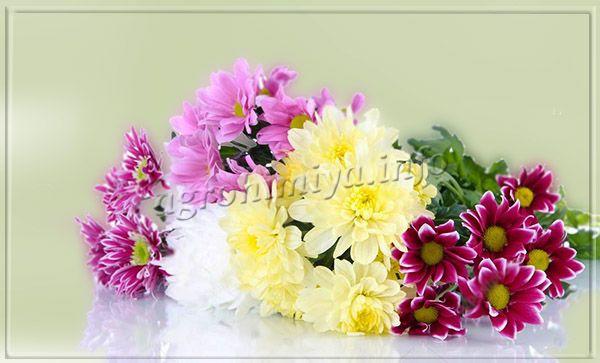

Small-flowered chrysanthemum varieties take root much faster than large-flowered ones
Even if cuttings of the same variety of chrysanthemums were cut and harvested at different periods, young cultures begin to bloom, as a rule, at the same time. But it must be borne in mind that fleshy cuttings take root much longer than thin ones. In this case, the early shoots give a higher, stronger stem.
Interesting!
Small-flowered varieties of chrysanthemums take root much faster than large-flowered ones.
If you follow the rules, the reproduction of chrysanthemum by cuttings will be successful, in a short time, even if the grower did not have such experience before.
Possible problems
When growing flowers, growers may face some problems:
- The appearance of small green insects is aphid. Control measures: rinse the plant well with water and spray with a special fungicide. The folk method consists in processing with soapy water.
- Leaves drooped - lack of moisture, water the plant abundantly.
- The buds do not bloom or fall off - the plant has suffered stress or there is not enough sunlight and heat. It is recommended to transplant to areas illuminated by the sun.
- The plant blooms, but the lower foliage turns yellow - this is a natural process. Just remove the dry leaves.
In order for the chrysanthemums from the bouquet to endure the winter frosts well, they are insulated before the onset of cold weather with leaves or sawdust.
Flowers are used in landscaping flower beds, garden plots. They grow well at home on windowsills. Chrysanthemums look beautiful when composing autumn compositions.
It is very easy to grow a chrysanthemum from a bouquet, the main thing is to adhere to certain rules of care and envelop each flower with your love. And then the plants will delight you with a riot of various colors.
Useful articles about growing chrysanthemums on our website:
Autumn cuttings
Cuttings of chrysanthemums in the fall are more preferred by those growers who grow this crop for sale. For such reproduction, you will need ready-made, flowering bushes obtained in spring.
Chrysanthemums have a good survival rate, so they can be cut not only in early but also in late autumn.
The bush is cut, dug out two weeks before the onset of autumn frosts and, together with an earthen lump, is transferred to a greenhouse or to another warm place. After 2 weeks of being warm, numerous shoots will appear on it.
Before dividing the plant into parts, it is watered abundantly with warm water. The shoots are separated from each other with roots and planted in fertile soil in pots, seedling boxes or in a greenhouse in the garden.
After the propagation of chrysanthemums by cuttings in the fall, plantings require careful care:
- immediately after planting, the cuttings are fertilized with a solution of ammonium nitrate (10 g of substance per 5 l of water);
- carry out regular watering and spraying;
- loosening the soil a day after each watering;
- making complex dressings for decorative flowering plants with a frequency of 1 time in two weeks;
- to avoid moisture evaporation, cuttings are mulched with peat or humus.
As soon as the shoots release 3-4 pairs of leaves, they are pinched to stimulate branching and the formation of a dense crown in future bushes. The second pinching is carried out at the stage when the plants reach 10 m in height. After double pinching, the bushes take on a compact shape and become resistant to adverse weather conditions.
With the arrival of spring, when the threat of the last frost has passed, the bushes are transplanted into a flower garden in their permanent habitat.
What to do after the roots appear?
Rooting is considered complete on average 30-35 days after planting the cuttings in peat.If you decide to propagate an interesting variety of chrysanthemum from a bouquet in winter, when it is still far from summer cottage experiments, then transplant the developing bush first into a spacious pot.
Choosing a flowerpot
The root system of a flower is of a surface type, therefore, the shape and size of the pot for transplantation are important. Chrysanthemums develop best in wide and low flowerpots with a diameter of 30 cm.
If you plan to subsequently transplant the flower into a flower bed, choose inexpensive plastic pots - they will be easy to cut so as not to injure the root system. For permanent cultivation, ceramic options are suitable - they provide good thermoregulation, oxygen flow to the roots and evaporation of excess moisture.


The soil
Chrysanthemums have established themselves as unpretentious flowers that do not require a strictly defined soil composition. Any loose, well-aerated soil rich in nutrients is suitable for them.
To fill the flowerpot, you can purchase a universal soil mixture or use garden soil with a neutral or slightly acidic reaction. It is advisable to first disinfect the outdoor soil by steaming or heating in the oven, you can also scald it with boiling water.
Please note: when chrysanthemums propagate, a drainage layer at the bottom of the pot is required, since these flowers do not tolerate stagnant moisture well.
For drainage purposes, you can use any suitable materials, from expanded clay and pebbles to charcoal and brick chips.
Landing
For young chrysanthemums rooted in water, small holes 4-5 cm deep are made, since due to the structure of the root system, it makes no sense to bury the seedling deeper. Then proceed as follows:
- Place the stalk in the middle.
- Spread out the roots gently.
- Sprinkle with earth, lightly crushing it with your fingers.
- To prevent the fall of a tall process, stick a stick next to it.
- Sprinkle well with soft water.
- Place a clear plastic bottle cap on top.
If you are replanting a cutting from a mini-container, do not destroy the earthy ball that has formed around the roots. Make indentations corresponding to the size and transfer the plant to a flowerpot, sprinkle with soil, water. For the first few days, keep the chrysanthemum under a transparent cover, then gradually accustom it to the external environment.


For a flower in a flowerpot, choose a place with good lighting, but without direct aggressive rays. In cold weather, chrysanthemums develop well on insulated loggias and balconies, southern window sills.
Home care comes down to timely, not too abundant watering when the earth clod dries and loosening the soil for good aeration. Do not overdo it with moisture - constant dampness contributes to the development of rot and fungus.
Note: while the chrysanthemum is growing in a pot, do not get carried away with feeding - it is easy to overfeed. To stimulate growth, it is enough to occasionally apply a minimum dose of nitrogen fertilizers.
Post-transplant care
Regardless of the season and place of chrysanthemum cuttings, after planting in open ground, young bushes need competent care, thanks to which you can achieve maximum decorative effect from the plants.
Humidity and watering
This culture does not react well to frequent waterlogging and can die, growing in an area with a close occurrence of groundwater. Therefore, when transplanting sprouted cuttings, a suitable place should be prepared and good drainage ensured.
Watering is required moderate and only after the land dries out. This is the plant that is better to underfill than overflow. Warm, soft water is used to moisten the soil. Watered at the root, trying not to wet the leaves and inflorescences.
Forming and pruning the crown
To create a lush and compact crown, you should periodically pinch the apical shoots. The crown can be made in any shape, it all depends on your preferences.
The first pinching for small-flowered varieties is carried out at the beginning of July - pinching the main branches. In August, young growth is plucked. Regardless of the variety, the pinching procedure is not carried out on this plant.
In order to prolong flowering as much as possible, the bush should be freed in time from withered and dried flower buds, which take away nutrients. Yellowed, dried and rotten leaves are also subject to removal - both for hygiene purposes and to stimulate the growth of young foliage.
Before the onset of cold weather, the plant is trimmed, leaving hemp up to 10 cm high.Then it is covered with fallen leaves, spruce branches or humus.
Support
For tall varieties, supports must be installed in advance to avoid breaking off long and fragile shoots. Wooden stakes or metal lattices are used as supporting devices.
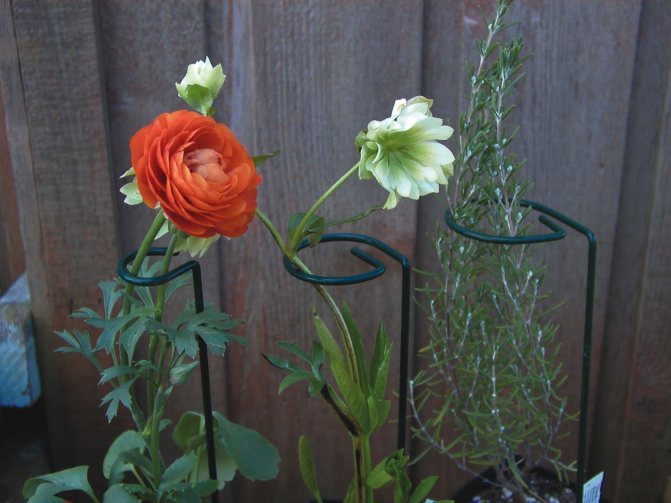

To support tall flowers, use supports
Loosening and mulching
During the active growing season, plants require a loosening procedure, which is carried out during the removal of weeds. During the period of budding and active flowering, chrysanthemums are mulched with a thick layer of humus or garden soil. A thick layer of mulch protects the bushes from freezing. Peat, garden soil or humus is used as mulch.
Fertilizers
To grow chrysanthemums from cuttings strong and lush, they must be provided with good nutrition. Top dressing of pot or street crops is carried out in three stages.
- The first fertilization is applied in early spring and always before the beginning of the formation of flower buds. The bushes are fed with mineral preparations with an increased dose of nitrogen, or nitrogen and complex mixtures are used in a 1: 1 ratio.
- The second feeding is carried out during the budding period. For this, special fertilizers are used for decorative flowering plants, mineral preparations or potassium-phosphorus fertilizers.
- The third and final feeding of the bushes is carried out after the plant blooms magnificently. Use phosphorus-potassium fertilizers or fertilizers for decorative flowering plants.
Additionally, the bushes are fed by the foliar method. Growth stimulants are used to process the aerial part. The aerial part is sprayed until the buds swell and during the period of active flowering.
Part of the mineral dressings for chrysanthemums can be replaced with organic fertilizers - compost or last year's manure.
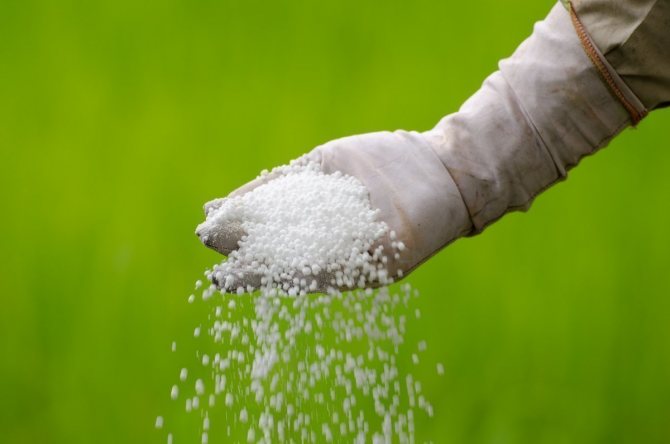

When applying root fertilization, it is important not to wet the stem and lower foliage of the plant, which can get burned.
Rejuvenating procedure
Every third year, the plant should be moved to another place in the flower garden, since the bush grows, and the soil for its development and flowering becomes scarce. As a result, the flower becomes vulnerable to many diseases and pests, loses its decorative effect.
The bush is transplanted in the spring - in April or May - and is combined with the chrysanthemum grafting procedure. Only in this case, the cuttings are not cut, but divided into parts along with the roots.
Pruning large-flowered chrysanthemums
Large-flowered chrysanthemums must be pinched in order, otherwise the flower will develop poorly - it will be small and underdeveloped. How to prune large-flowered chrysanthemums? Such chrysanthemums are cut off as soon as the eighth leaf appears on the shoot, only in this case the chrysanthemum is not cut off, but pinched, although you can simply cut off the top. Such pruning allows the plant to branch, let out side shoots, by the way, of which only 2-3 of the healthiest are left. The rest also need to be removed so that the bush is powerful, but developed. But the cuttings that you cut can, again, be used for rooting and obtaining young plants of this variety with all varietal characteristics. In these chrysanthemums, unnecessary branches in the area of the central flower buds must also be removed.As a result of such pruning, there should be only one flower on the plant, but it is large and beautiful.
Reproduction and pruning of large-flowered chrysanthemums
By resorting to this method of propagation of chrysanthemums, you can get new plants with maternal traits from any variety!
Further primary care
The stalk planted in the ground is placed in a slightly shaded place. The optimum temperature for rooting is + 15… + 17 ° C. At higher temperatures, roots develop faster, but at the same time, the risk of decay is higher.
At the rooting stage, abundant watering is required, the air humidity should also be high. In the first 5–8 days, it is desirable to create greenhouse conditions for the sprouts. When the top of the seedling grows, it can be transplanted to a permanent place.
If you used the autumn method of cuttings, the sprouts should be kept until spring in a moderately warm room (in a cellar or on a warmed balcony).
From time to time, the soil is moistened, preventing it from completely drying out. In the spring, the seedlings are transplanted to a permanent place. Pick the right stalk, provide it with the right conditions for growth, and soon you will have a healthy young bush.
grow-
Breeding time
Chrysanthemum cuttings are carried out practically throughout the year.
The specifics of caring for seedlings and partly the quality of the future plant depend on the choice of time:
- In winter. In January or February, you can get sprouts if, after a short period of dormancy, you move the pot of chrysanthemum to a warm room and provide the plant with abundant watering. At room temperature, young shoots will appear in 1–2 weeks. Cuttings are cut when they reach a length of 10–12 cm. In general, this time is not recommended for chrysanthemum propagation - the rooting process takes about a month, seedlings need additional lighting, and they often turn out to be elongated.
- In the spring. March and the first half of April are suitable for rooting early varieties, the second half of April and May for late varieties. In pot growing, the plant is also brought home in advance. In warm regions, it is possible to carry out cuttings of the bush when grown in the open field. The rooting period is 1–2 weeks.
- In summer. The sprouts take root quickly and require minimal maintenance. It is not recommended to cut chrysanthemum in hot weather or during a cold snap, as well as in rainy and damp weather.
- In the autumn. To propagate the mother bush, after the end of flowering, it is cut to the root, fed with nitrogen and left in the soil for 2 weeks. After the basal shoots reach a height of about 8 cm, the bush is dug up, brought into the greenhouse and divided into cuttings there, and they are not cut off, but broken off from the bush along with the root.
Transplant in open ground: timing and technology
Rooted chrysanthemum cuttings are planted in open ground from mid-April to mid-May, depending on weather conditions. Despite the cold resistance of chrysanthemums, young, not yet matured plants may not tolerate planting in cold soil or exposure to short-term spring frosts.
Important. If leaves have already formed on the bush and it is completely ready for planting in open ground, and it is still cold outside, the plant needs to be provided with coolness and maximum lighting. When kept warm, even with an abundance of light, the plant will stretch out. The best option for keeping chrysanthemums in a pot in this case is installation on a glassed-in balcony or loggia.
For planting chrysanthemums, a sunny, dry area is selected. Preferably on a hill. Planting chrysanthemums in lowlands, where moisture stagnates for a long time, is contraindicated. In such conditions, the roots of the plant will begin to rot.
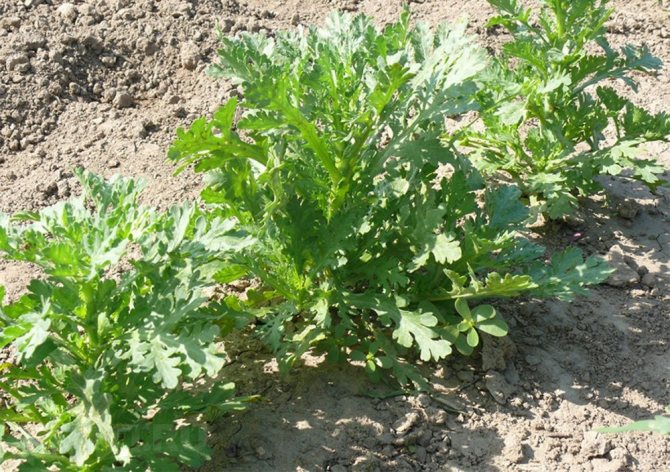

In open ground, grown chrysanthemum cuttings can be planted in spring.
The site for planting cuttings is carefully dug up, 5 kilograms of humus or peat per square meter, 500 grams of wood ash and 70 grams of nitrophoska are added to it.
Shallow but wide pits are prepared for planting, on the bottom of which drainage is laid (broken red brick, expanded clay, granite chips or small pebbles). The distance between the planted plants should be 30-40 centimeters. The cuttings are placed in the soil at the same level at which they grew in pots.
The transplant is carried out by the transshipment method, trying not to damage the roots. The plants are removed from the pot along with a lump of earth and placed in a prepared hole. The surface is lightly tamped and watered abundantly. To retain moisture in the soil, the surface is mulched with peat or dry foliage.
Advice. To prevent the planted bush from being swayed by gusts of wind, it is necessary to provide a support. The plant can be fenced off with a low fence, which will protect the plant from gusts of wind, and at the same time will serve as a support.
Further care
Completely rooted sprouts, for which cultivation in a potted version is provided, after this time, can be transplanted into a separate container filled with a mixture of garden soil, leaf humus and peat in equal proportions. This is the final stage in the procedure called "How to grow a chrysanthemum from a bouquet."
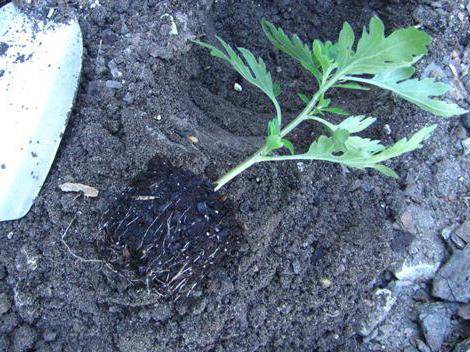

In a pot, on the bottom of which a layer of expanded clay is laid, the plant is transferred along with an earthen lump, trying not to damage the roots: while they are still very small, fragile and brittle. The successful development of the plant is subsequently promoted by the correct location, maintaining optimal light and temperature conditions, regular watering and feeding.
Material requirements
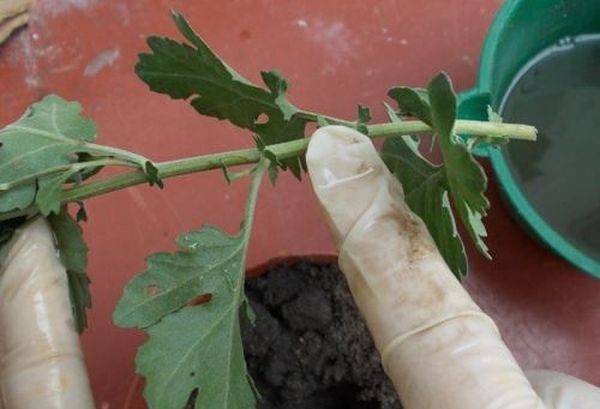

To grow a strong plant, you need to choose the right stalk. It should be healthy, resilient, with long internodes and a moderately hard base: tissue that is too soft will rot, and the stiff one will slowly and difficult to take root. The softer the shoot, the longer it should be (from 5 to 8 cm). There should be 3-4 leaves on the sprout.
You can also root a sprout from a bouquet. To do this, you need to choose healthy, not stiff twigs with a length of 8 to 15 cm. Side shoots without flowers or buds are well suited. The main thing is that they are not too soft.
You can take a stem with a flower. Some growers recommend using only recently cut plants, others - to specifically wait for the leaves to wilt slightly. You can try both ways.
Which flower is right
Imported flowers for bouquets are treated with specialized products and solutions that prevent them from taking root and withering ahead of time. For the preparation of viable cuttings, only domestic specimens from local greenhouses, and not brought from abroad, are suitable.
You can root flowers immediately or after the flowers have stood in the bouquet for several days, decorating the room and delighting the eye. Korean varieties with small flowers that take root quickly are best suited for grafting. But the Indian ones will require more effort.
How to root chrysanthemum from a bouquet at home
How to choose a branch for germination
How to propagate chrysanthemum with cuttings from a bouquet and where to start? First you need to prepare a suitable specimen, and you need to choose half-stiff stems from bouquets. The shoots on the sides of the main stem are considered the most viable and perfect for reproduction.
Shoots selected for propagation should be cut from the main stem, such shoots will be able to root better. But you need to leave a small "heel" at the end - a little from the base of the main stem. Further, on the harvested shoots, it is recommended to remove all leaves, except for the top 2-3, which are cut off by a third. This is to stimulate root growth. In order for the future bush to branch well, it is recommended to pinch the top.
The optimal time for rooting is winter or late autumn: in November-January or February.The main thing is to choose a suitable stem and plant it during this period. Growing chrysanthemums from a cutting step by step from a donated bouquet is possible after studying the technology presented below.
Important! Coarse and thick shoots with many knots will not give roots.
General idea of the plant
Chrysanthemums are plants of the herbaceous or semi-shrub type. Depending on the varietal accessory, the height of chrysanthemums is 20-80 cm. The most diverse inflorescence color looks great against the background of dissected, serrated or simple leaves of a light or dark green shade, which are placed on the stems of the plant in the next order.
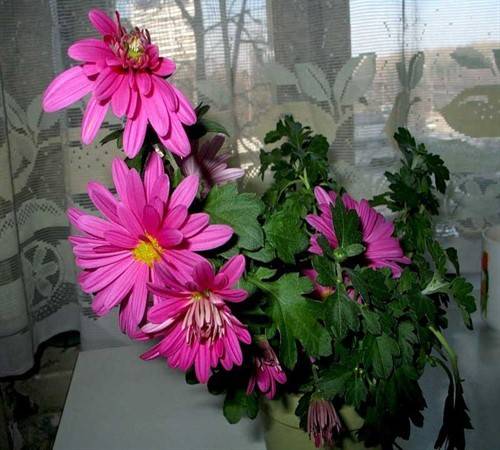

Currently, more than 100 varieties have been bred, differing from each other in the height of the bush, the structure of the inflorescences, color and flowering times, therefore it will not be difficult to choose a variety that would look great in single compositions or on an alpine hill, and you can propagate your favorite plant by one of the following ways.
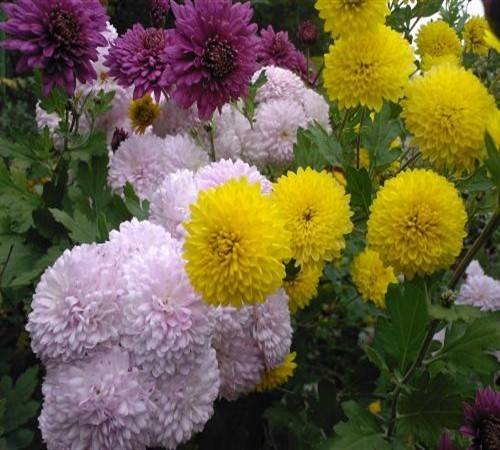

Planting planting material in the ground
The abundance of flowering of a future plant largely depends not only on the variety, but also on the conditions of its growth.


Seat selection
For planting a plant on the street, a windless place with midday shade is suitable, since in the shade the inflorescences become smaller, and in conditions of constant presence in direct sunlight, they quickly fade, the leaves turn yellow and fall off.
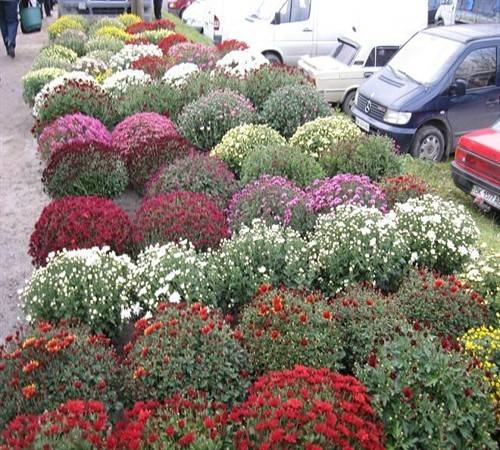

The elevated area will allow you to avoid stagnation of water during a rainy season or with a close occurrence of groundwater, since the roots of the chrysanthemum are located parallel to the surface.
Indoor chrysanthemum requires diffused light. A small mesh or gauze fixed on the window will allow you to achieve the effect of diffused light.
Soil preparation
For the full development and abundant flowering of chrysanthemums, sandy loam or loamy soil with a neutral or slightly acidic reaction is suitable, which must be dug up a month before planting, remove all weeds and apply bird droppings or humus as fertilizer.
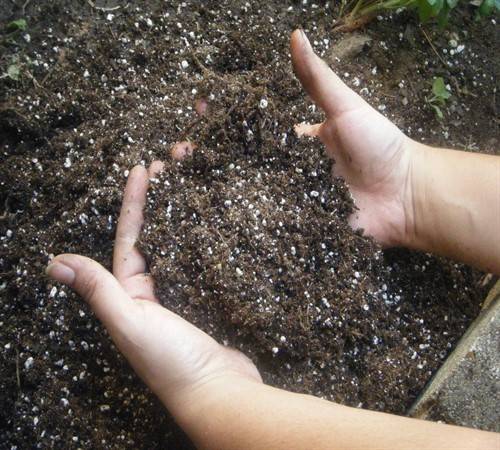

Planting process
Planting of plants in the ground is carried out in cloudy weather, or early in the morning or late in the evening in sunny weather, since the direct rays of the sun have a detrimental effect on young plants.
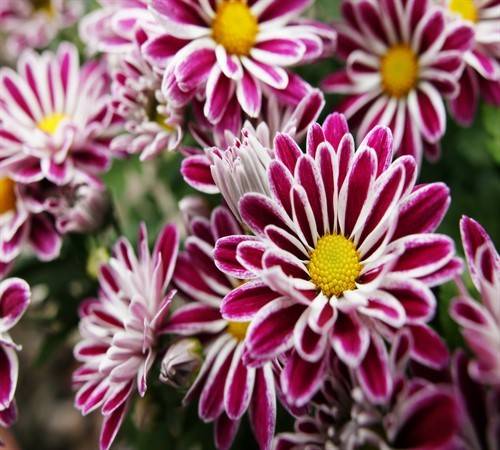

Planting planting material in the ground is reduced to the following works:
- Dig a hole about 40 cm deep under each plant at a distance of 30-50 cm from each other.
- Pebbles, broken brick or other materials that play the role of a drainage system are laid at the bottom of the holes.
- Fertile soil mixed with sand in a 1: 1 ratio is poured over the arranged drainage.
- The seedling is lowered into the hole, deepening it by 4-5 cm and compacting the earth around the flower to avoid the formation of air pockets.
For the favorable development of the plant, constant watering, periodic loosening of the soil and fertilization, as well as the timely removal of side shoots are necessary.
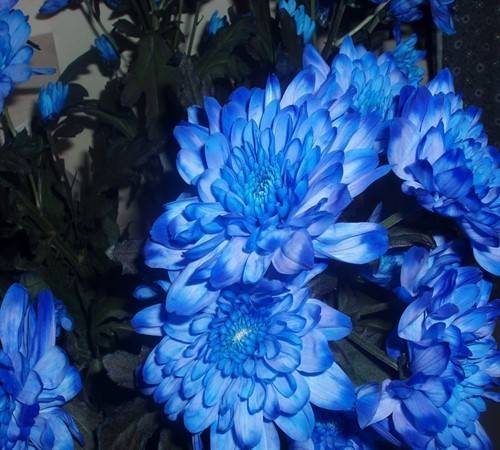

Plant transplant in open ground
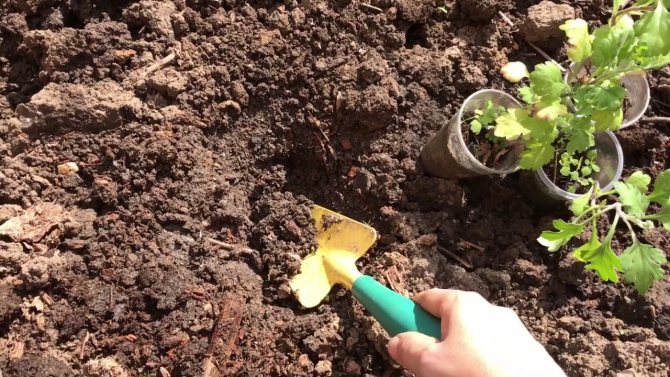

It is better to transplant chrysanthemums into open ground in spring, when the threat of frost return has passed. For central Russia, this is the end of May or the beginning of June, for the northern regions - June, and for the southern regions - the end of April or the beginning of May.
Transplant instructions:
- Prepare shallow holes in a 40x40 cm pattern.
- Lay a layer of stones on their bottom: they will act as a drainage system.
- Remove the plants from the pots and place each in its own hole.
- Deepen the bushes to the previous level.
- Water them liberally and tie them to a support.
Advice! And it is better to cover the first few days of chrysanthemums with a film. So it will be warmer for them, and they will take root faster.
Soil preparation
To successfully grow chrysanthemums from cuttings, you need to prepare a good potting mix. When planting in cups, seedling containers or on a garden bed in a greenhouse, purchased peat, forest land with sand (1: 1) or perlite mixed with sand in an equal amount are suitable.All formulations have the qualities necessary for culture - good moisture and air permeability.
You should also take care of the acidity of the soil. Ornamental chrysanthemum grows poorly and blooms poorly on acidic soil. To reduce acidity, slaked lime, crushed chalk or dolomite flour can be added to the soil.
When planting in fertile, slightly acidic soil, any florist, even a beginner, can get a chrysanthemum from a cuttings.
In summer
It is best and much easier to cut chrysanthemums in the summer - in order for the shoot to take root, it is enough to stick it into fertile and well-moistened soil. But experienced flower growers advise adhering to the general rules of summer cuttings in order to get a healthy and lush blooming bush as a result.
- The lower part of the cutting, which has already become woody, takes root much worse than the green young part, therefore, for cutting chrysanthemums, it is better to use apical shoots about 15 cm long.Lateral stems are also good planting material, the main thing is that they have leaves and 1-2 buds.
- Stems are planted on loose soil enriched with humus. At first, young plantings will need protection from the scorching sun, so they are immediately planted in partial shade or provide shading when planting in a sunny place.
- In order for rooting to be successful, the plants are often, but moderately watered, sprayed, the soil is loosened after watering.
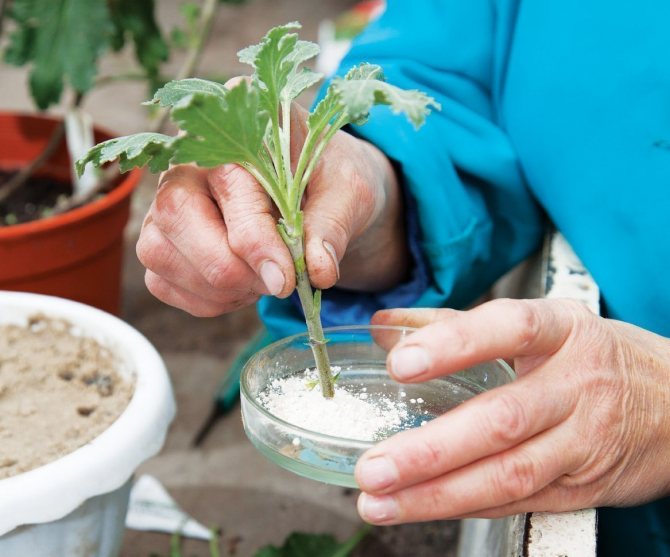

After 3 weeks from the moment of planting and regular maintenance, you will notice how the stems have started to grow.
After the development of 2-3 pairs of leaves, they are pinched, then upon reaching a height of 10 cm, the apical shoots are re-pinned. This will ensure rapid branching and the formation of a dense crown in the shrub.
Rules for selection and cuttings of the stem
Chrysanthemum rooting is rarely a problem, and the roots can give almost any kind of shoots. But you should not try to germinate too young, not gaining strength and too old, lignified shoots. Young shoots rarely take root, and old ones begin to rot before they germinate.
For harvesting cuttings, you should choose a chrysanthemum from a bouquet with strong, semi-lignified, richly colored side shoots growing from the leaf axils. The most viable are the lateral processes located on the main stem up to the flowering shoots. But if signs of yellowing are already noticeable on the shoot, you should not root it.
Important. You should not choose too thick, coarse shoots and cuttings for rooting, on which internodes are too often located.


Only strong lateral shoots are suitable for cuttings.
Selected viable shoots are cut from the mother stem in such a way that a "heel" remains at the lower end, that is, a part of the base of the central stem. On the blanks, all leaves are removed, except for 2-3 apical ones. The upper leaves must be cut off by a third of the length. This technique will limit the growth of leaves on the shoot and stimulate the formation of roots on it. To ensure future branching, the crown of the shoot must be pinched.
Rooting technology of cuttings
Depending on the rooting time, cuttings can be planted in pots or directly into open ground. But first, the cuttings must be germinated in water. For germination, the prepared shoots are placed in a glass with clean, filtered or boiled water. To prevent bacteria from multiplying in the water, an activated carbon tablet is added to it.
Before installing the cutting in water, it is recommended to hold it for 3-4 hours in a solution of a root formation stimulator: Kornevin, Heteroauxin. The concentration of the solution recommended on the package can be increased by a third.
Requirements for the composition of the soil and dishes for planting
Roots on cuttings appear in 4-5 days. After that, the rooted shoots can be planted in the soil.
The substrate for sprouting chrysanthemum cuttings should be slightly acidic or neutral. Acidic soils are contraindicated for this plant. The wood ash added to the substrate provides optimum acidity.
For rooting chrysanthemum cuttings, choose a wide container.
For good growth, cuttings need a large supply of nutrients, so it is recommended to add humus or well-rotted compost and a small amount of nitrophoska to the soil. The soil for planting chrysanthemums must have air and water permeability, therefore, perlite or vermiculite is added to the substrate to give maximum friability. Cuttings can also be planted in a mixture of vermiculite and peat.
The root system of the chrysanthemum is superficial, and tends to grow not in depth, but in breadth. Therefore, the container for growing chrysanthemums is selected shallow, but wide enough, at least 30 centimeters in diameter.
Cuttings in spring
For strong cuttings, a healthy mother plant should be used, free of painful signs and hints of pests. Harvesting of planting material is carried out in the autumn. This is done as follows:
- the ground part of the plant is cut at the root;
- the root system is dug out completely together with a clod of earth;
- the roots must be placed in a volumetric container and filled with voids with a sand mixture;
- all this "structure" should be moistened and put in a cool place, a cellar or basement room would be an ideal place;
- provided that you do not have such a room, you can store a vessel with roots in any of the rooms, the main thing is that the air temperature does not rise in it more than + 7 degrees;
- if the room is too warm, the plant will begin to germinate, release shoots and buds.
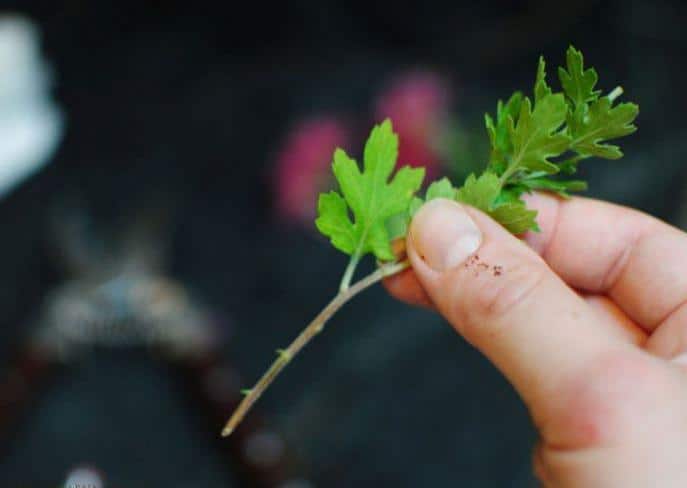

Planting mature cuttings in the garden
How to grow chrysanthemums from a bouquet outdoors? It is possible to plant the adopted young plants from cuttings in the garden in late May or early June, that is, when the soil warms up and the threat of recurrent frosts has passed. Previously, the site is prepared for planting: it is carefully dug up, adding 1 sq. m 5 kg of humus and peat, 0.5 wood ash and 60-70 g of nitrophosphate. It is worth taking care of the arrangement of drainage, which will increase the aeration of the soil and prevent stagnation of water that can cause various putrefactive lesions of the roots.
Plants should not be planted too tightly, the distance between them should be at least 35-40 cm. When planting, the tops of the plants are pinched, stimulating branching. The planted crops are fed twice a month, watered as needed with warm water.
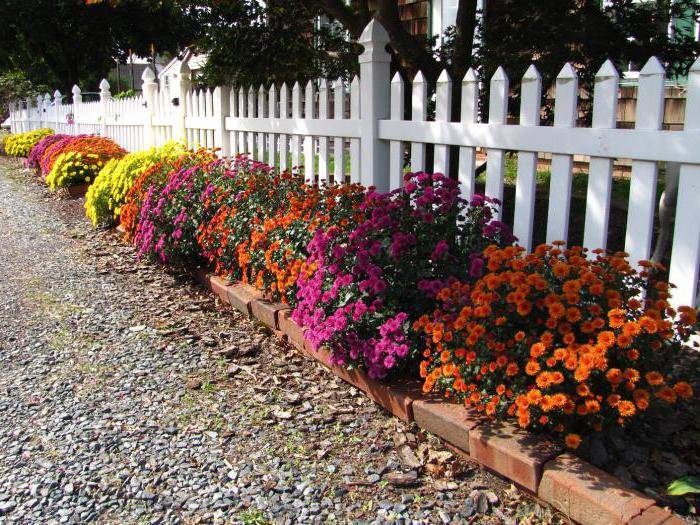

A similar agricultural technique is applicable to Korean varieties of perennial chrysanthemums. They grow in one place for 2-3 years. Then they require a transplant. Large-flowered chrysanthemums are grown mainly in annual crops and, most often, in a greenhouse.
So, we tried to find an answer to the question of how to grow chrysanthemums from a bouquet, and we hope that this publication will help novice growers.
This story is a continuation of a series of posts about my winter dacha fun. My birthday is in February, so for him they gave me a mixed bouquet, in which there was one chrysanthemum. When it was cut, I, of course, do not know, but my bunch safely stood for a week, after which it lost its decorative properties, and I decided to throw it away.
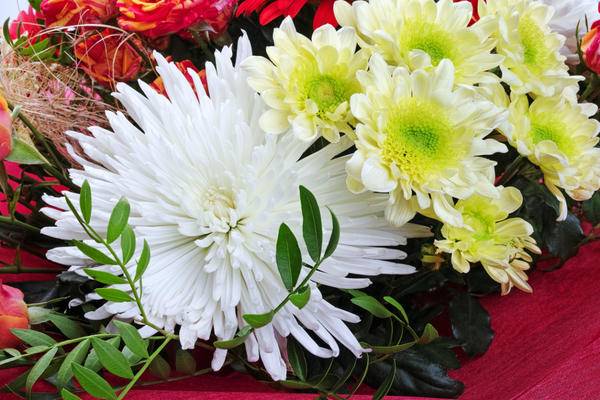

Chrysanthemums from a bouquet can be propagated by cuttings
I took off the cellophane wrapper (don't throw it into the compost heap!), The bouquet disintegrated, and I saw that the chrysanthemum has 2 side shoots. The decision to try to root them arose instantly.


Chrysanthemum from a bouquet, photo by the author
I carefully separated them from the stem: one, frankly, was not very promising in this regard (too young, he had not even begun to lignify yet), but the second was good.
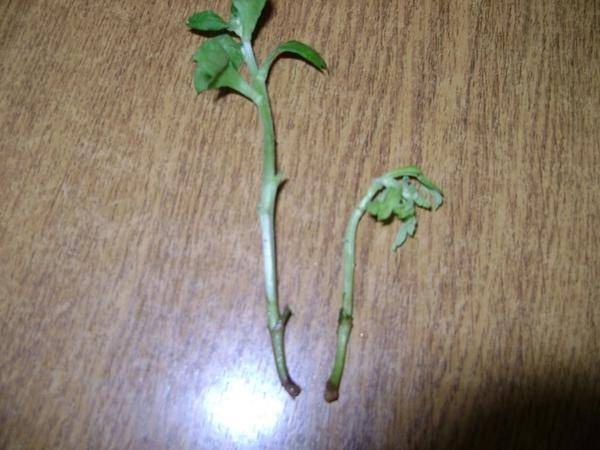

Separated cuttings, photo by the author
Looking at the withering leaves of the chrysanthemum, I doubted: is it worth starting, because they probably will not take root, in the cut for at least a week. But then I thought - what if you get lucky! I had a stock of soil mixture for seedlings (stood in the boiler room), I dipped the cuttings in Kornevin, planted and covered with jars. All this action took place on February 27.
The small stalk could not take root, two days later it died. And the second held on! I took off the can, ventilated it and encouraged it, saying: “Well done, hold on, I believe in you!”. The root system was growing for about a month, and then the long-awaited young shoots appeared - my baby chrysanthemum started to grow! Look how beautiful she is now!
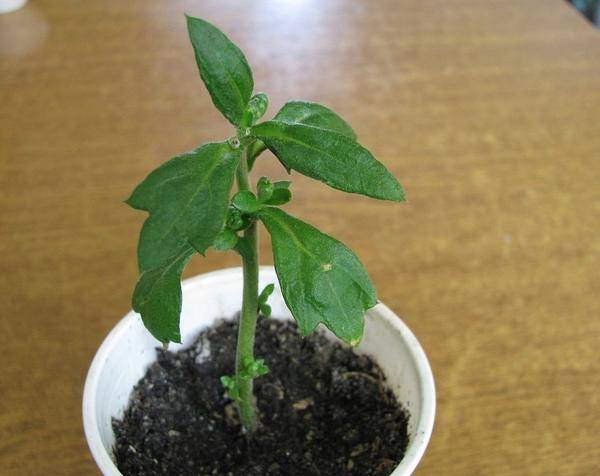

A cutting rooted in February. This is how it looks in April, photo by the author
So suddenly I got another chrysanthemum. I am very glad that I put my doubts aside and did not send her to the compost heap. Have you ever rooted a plant from a bouquet? If you suddenly have such a desire, these materials will certainly come in handy:
- Secrets of growing chrysanthemums
- Chrysanthemum cuttings
- Is it possible to cut chrysanthemum in autumn
Cuttings in autumn
The easiest way to propagate from a bouquet is to wait for the flowers in the vase to take root, and then transplant them into a container with soil. The root formation process can take a long time, so please be patient. Shoots with signs of yellowing are not subject to rooting.
To grow a chrysanthemum from a bouquet at home, the most liked flower with green shoots is chosen for harvesting cuttings. The upper part of the stem is cut off, flowers and buds are removed, it is rooted, and by spring a strong fluffy bush grows, exactly repeating the flower from the bouquet. All actions are similar to propagation with a simple cuttings.
For spring cuttings, a mother bush is required, the harvesting of which is carried out in the fall, and fresh shoots are obtained in the spring.
After flowering, the best specimens are left for the winter as mother plants, so that later chrysanthemums can be used for grafting.
In late autumn, faded shoots are cut off near the ground, dug up and placed in a pot, left in storage in a cool, bright room until next season, at a temperature of 2 ... 7 degrees. Do not overdry - the ground should be slightly damp throughout the winter.
During spring reproduction, the mother chrysanthemum bush is transferred to a warm room in mid-February and watered well. After one to two weeks, young shoots begin to appear. When they reach 10 cm, you can cut the cuttings from the tops, leaving two pairs of leaves on the stumps. Then new plants will grow on them faster, which can also be cuttings.
The lower leaves are removed from the cuttings, then planted in a box with moist soil, which should be transferred to the open air in a place protected from rain and wind. After two weeks, when the cuttings are rooted, they are transplanted to a permanent place.
If it is required to save more bushes before spring planting, then they are tightly installed in wooden boxes and stored under the same conditions. At higher temperatures, shoots may appear ahead of time.
A lot depends on the soil composition so that the cuttings of chrysanthemum feel "at home", it is necessary to prepare a special mixture based on purchased peat, forest soil, sand or perlite. All these components will help the plant to "breathe" unhindered and to be enriched with moisture.
The acidity of the earth should be neutral, only under this condition can we talk about normal reproduction and growth of the plant. If necessary, the soil should be deoxidized by adding ash, chalk or dolomite flour to it.
Provided that the soil has all the necessary qualities, even a gardener without experience will be able to grow gorgeous chrysanthemum bushes in one season.


For strong cuttings, a healthy mother plant should be used, free of painful signs and hints of pests. Harvesting of planting material is carried out in the autumn. This is done as follows:
- the ground part of the plant is cut at the root;
- the root system is dug out completely together with a clod of earth;
- the roots must be placed in a volumetric container and filled with voids with a sand mixture;
- all this "structure" should be moistened and put in a cool place, a cellar or basement room would be an ideal place;
- provided that you do not have such a room, you can store a vessel with roots in any of the rooms, the main thing is that the air temperature does not rise in it more than 7 degrees;
- if the room is too warm, the plant will begin to germinate, release shoots and buds.
This method is the most productive for the sale of young animals. For this method, independent flowering bushes obtained in the spring are used.
In general, chrysanthemums have a very high survival rate, so you can breed it almost all year round.
The bush should be dug out before the onset of cold weather and placed in a heated greenhouse. Already after 14 days, you will see many sprouts on the plant. Dividing the bush should be done after watering. Shoots, along with part of the root system, are distributed in separate containers in fertile soil.
What is needed for autumn breeding:
- After planting, add a solution of ammonium nitrate at the rate of 10 g per bucket of water.
- It is necessary to spray, loosen and water the flowers constantly.
- The mulch will help retain moisture.
- Every two weeks it is necessary to fertilize the plants with a special complex for beautifully flowering plants.
After four pairs of leaves appear on young plants, they are pinched. This will allow the plant to branch more densely, and the crown will become beautiful and dense. The second haircut should be done after two weeks.
In the spring, when the soil warms up well, you can start planting ready-made chrysanthemum bushes in a permanent place.
Florists successfully use several ways to get "babies". These methods are:
- cuttings;
- seed reproduction;
- division of the mother liquor;
- rooting cut flowers from a bouquet.
Each method has its own advantages and disadvantages. The gardener determines the best option on an individual basis.
This option for getting "kids" is not difficult. It is necessary to wait for the bouquet to fade. After that, all the leaves are removed, and the top is pinched. The water in the vase is regularly renewed until roots appear. After that, the seedlings are transplanted into a garden bed or flowerpot. The seedlings should not be too deep. Enough five centimeters. Dry buds are ideal for harvesting seeds. In the spring they will give life to young animals.
Cuttings are an effective, proven method of obtaining young stock. The seed method and the principle of dividing the bush do not allow to properly preserve and transfer all the best varietal characteristics from the mother plant to the daughter plant. It is the cuttings that become the basis for growing powerful, healthy bushes with good immunity to major diseases. Such beauties are characterized by abundant flowering. For this reason, grafting is considered a reliable and easy method.
A suitable substrate will be a mixture of earth, humus and sand in a 1: 1: 2 ratio. On top of the pot, you will need to add river sand and peat in equal amounts. The layer should be no thicker than 5 centimeters. As a soil for rooting planting material, you can use a combination of sand in equal proportions with:
- sphagnum;
- perlite;
- vermiculite;
- peat.
An important step is the process of disinfection of the prepared soil mixture.This allows you to protect future seedlings from all kinds of diseases and makes it possible to grow strong seedlings. You can ignite the soil in the oven for at least an hour. The second option is to keep the substrate over the steam of a water bath for four hours.
Spring procedure
This is the best period for grafting. For early species, the optimal time is March-April, the middle and late ones are from April to May.
Starting from the second half of February, the mother bush is moved to a warm room and abundant irrigation begins. It is advisable to feed with organic matter. The key to good health and rapid development of young animals will be the introduction of ammonium nitrate. After the appearance of new young branches, it should take about a week and a half for them to reach 10 centimeters in length. Then they are cut off. Such a cutting should have at least four internodes.
Read more: Keeping and feeding bulls at home
To prepare planting material, remove the lower leaves on the cut shoots and shorten the upper ones by a third. Only a stump with a few leaves is left on the mother plant. They will become a new growth point. Only firm and firm cuttings are suitable for the propagation procedure. Twigs that are too soft or hard will not work. Existing buds must be removed.
A moisture-saturated substrate is required. The depth of the fossa should not exceed two centimeters. The distance between the branches is five centimeters. Up to four workpieces can be placed in one container. If possible, they are seated one by one in cups or pots.
In the case of early varieties, the container with the plantings is covered with plastic wrap and taken out into the street. In such a greenhouse, the "roof" should rise 40 cm above the tops of the young. When watering, the film is lifted. When rooting, new leaves appear. After the appearance of five to seven pieces, pinch the bush.
A week before disembarking on the street, the seedlings begin to harden. To do this, the young are left on the balcony or veranda, after removing the film. At night, the bushes must be covered. After the threat of recurrent frosts has passed, the seedlings are moved into open ground.
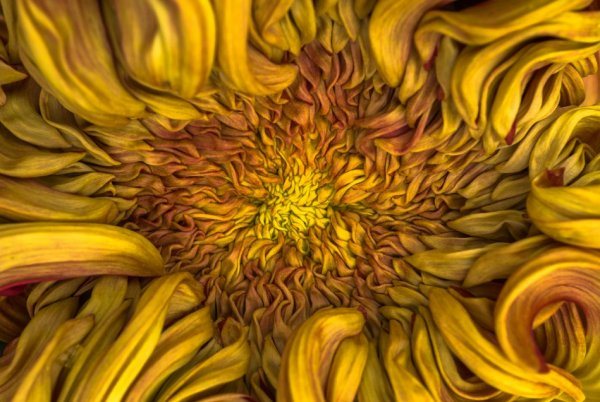

There is a hassle-free cuttings option. It does not need germination or growing seedlings - you can directly plant blanks on a flower bed. This can be done in May-June, when the summer finally comes into its own and becomes really warm. Shoots are cut on overwintered bushes. These should be young branches of the current growing season. Their length should not be less than 15 cm. Cutting the shoots is required to half.
The workpieces are immediately identified on a high ridge. It is required to sprinkle them with sand and thoroughly spill the soil with water. A shelter is organized from above. There should be at least half a meter between the film and the tops of the young. On warm days, the shelter can be removed. Install in cold weather. Two weeks after the appearance of the root system, "adolescents" are transplanted to a permanent place.
Cutting in the summer is even easier. Sometimes a shoot planted outside of any rules and recommendations develops into a beautiful bush. It is advisable only not to cut off the shoots in too hot, cold or unstable weather. Green tops up to 15 cm long are suitable. It is better to plant them in a shaded area.
Step-by-step grafting and rooting technique
For those who are going to cut their favorite flower from a chrysanthemum bouquet for the first time, but have never done this before, there is a very simple and understandable instruction for this procedure.
Selection of stems for grafting
Chrysanthemum in a pot - home care
Do not blindly rely on the fact that an unpretentious chrysanthemum will be able to quickly and easily root all cut cuttings.In order to breed a really beautiful and viable flower, it is necessary to carefully select the material for germination and subsequent planting in a pot or flower bed. An ideal cutting should meet the following requirements:
- the absence of any signs of rot damage over the entire area of the stem;
- strong and healthy appearance;
- too young or too old specimens are not suitable;
- the average thickness of the stem and its sufficient rigidity.
For further germination, it is recommended to choose cuttings that have lateral branches, because they can start up roots and multiply faster than others.
Important! Material from weak, diseased or too old chrysanthemum bushes should not be used as cuttings. They will either not be able to release roots at all, or they will rot immediately after landing in open ground.
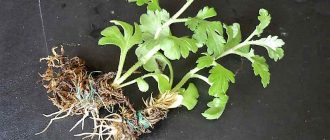

Selection of chrysanthemum stems for grafting
The selected planting material is soaked (bottom) in a solution stimulating root formation, such as:
- Epin;
- "Zircon";
- Kornevin.
The drug in a very small dosage (at the tip of a knife) is poured into a vase (container) with stalks of chrysanthemums that you wanted to cut off for germination. Some growers prefer to simply dip the bottom cuts in powder and then insert into a vase. The duration of exposure of the planting material in such a solution is from 1 hour to a day, the ideal time is a couple of hours.
Timing of rooting cuttings
The best time for chrysanthemum propagation by cuttings followed by rooting of cuttings is spring, starting in mid-March and ending in late May. The plant enters early bloom in March or April, late and medium blooms in May.
The stalk and flower size of the plant should also be taken into account. So, multi-stem chrysanthemums with large and small inflorescences are recommended to be propagated in the month of March, single-stem ones - in April-May, and also to capture the first ten days of June.
The duration of rooting of cuttings in the first three months of the year is from 20 to 25 days, in warm April or May - about 2 weeks.
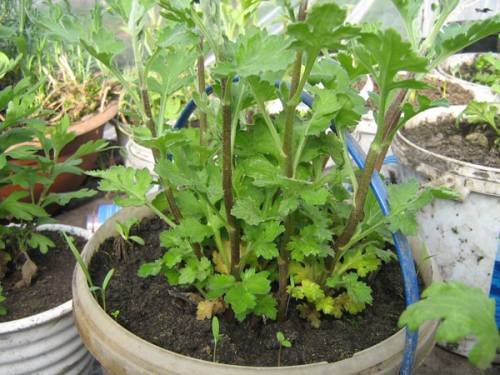

Rooted chrysanthemum stalk
The specific rooting time is determined by the air temperature (optimally 18-23 degrees) and the moisture content of the substrate.
Soil and pot for planting cuttings
There are also requirements for the capacity where the flower will be planted. It is better to take a large pot so that the roots sprouted on the stalk have the opportunity to develop in all directions.
At the very bottom of the pot, it is necessary to pour a layer of drainage from brick ground into crumbs, building fine sand or expanded clay. Such a layer will help protect the delicate root system from rotting.
The soil for the soil is taken light, slightly acidic or neutral pH, it is desirable to mix it with a small dose of fertilizers.
Important! The diameter of the pot should be at least 28 centimeters, on the lower side (at the bottom) there should be several holes to drain excess moisture. Before the direct planting of cuttings, it is recommended to thoroughly shed the soil with water to saturate it with moisture. You should also loosen the soil in the pot, remove all weeds along with the roots.
Light soil for better rooting of flowers is made up of leaf and sod land, to which 1 weight fraction of river sand is added, and a little peat can also be introduced. Organic fertilizers are suitable for the substrate: manure or chicken droppings.
If you plan to grow a new chrysanthemum bush in a flower bed, then you should pick up loose, moisture-permeable and nutrient-rich soil in a sunny and slightly elevated area. In such conditions, the flower will not pull out shoots and bloom at the wrong time.
Rooting cuttings and planting in the ground
Cuttings that have successfully passed the rooting stage can be safely planted in a pot or open ground.
On a flower bed, they should not be placed too close to each other, the step is from 0.3 to 0.6 meters. A dense planting is not allowed, otherwise the flowering plant will not develop. The recommended depth of the holes is no more than 1.8 cm. The root system of the chrysanthemum bush grows parallel to the soil, so you should not bury the cuttings too deep in the ground. Around the stalk placed in the hole, the substrate is carefully compacted and poured with water.


Planting cuttings in the ground
Advice. After planting all the material, the surface of the flower bed is spilled with a weak solution of potassium permanganate for disinfection and protection from bacteria.
Freshly planted cuttings are covered with a transparent film or glass jar (for each stem) for a couple of weeks, while it is important not to touch the shoots. The shelter must be periodically ventilated (especially glass).
The seedlings are protected from blowing by the wind using a fence, it can also be used as a support for thin stems. A few hours after planting, young chrysanthemums may weaken, but with proper care, they quickly come to their senses.
On the same day, the growing point is removed from the seedlings, this is called the first pinching. After a few (2-3) weeks, re-pinching is carried out, the apical part of the shoot with a couple of nodules is cut off. This is necessary to form a beautiful bush shape.
For the first few days, planted cuttings should be shaded with a small canopy for early survival.
Chrysanthemum description, photo
Distinguish between perennial and annual varieties. All of them belong to the Astrov family. They are shrubs or grasses. The stem length can vary from 0.5 to 1.5 meters. Flowers are collected in baskets. Most often they are quite large. Many varieties have double inflorescences. Shoots can be not only naked, but also pubescent. The plant forms achene fruits.
There are about thirty known wild species. Their natural habitat is the northern and temperate zones, located mainly in Asia. According to archaeological research, two and a half thousand years ago, the culture was known in China. The flower petals have even been used in cooking. Even the famous sage Confucius mentioned him in one of his treatises.
Then the plant got to the Land of the Rising Sun, where it became a revered symbol of the imperial family. In the countries of the Old World, they learned about the flower in the eighteenth century, but they began to actively grow it only a century later.
In the scientific community, there are disputes about the origin of a common species - garden chrysanthemum. Some researchers believe that its ancestors are the Japanese variety with small flowers and the Chinese with large ones. Other scientists put forward versions of the combination of a species from China with an Indian small-flowered one. Until now, breeders are actively engaged in the creation of new varieties of the amazing sunny flower.
Top dressing
During rooting, the plant does not need feeding, but after 3-4 weeks the roots are already formed, and they will need nutrition. To stimulate the development of the root system of young chrysanthemums, fertilizers of the OZhZ series are suitable, which are organo-mineral complexes used for root and foliar dressing. A tablespoon of fertilizer is diluted in a liter of water and the solution is infused for 10-20 hours. This infusion is watered weekly on rooted plants. The normal time for young chrysanthemums to successfully take root and get stronger is 2-3 months.

